Looking for top-tier traditional touring bikes? You’re in the right place. As the cycling industry evolves, particularly in the gravel and bikepacking realms, the landscape of adventure cycling has changed dramatically. Yet, traditional touring bikes, once the go-to for adventure, remain as relevant as ever for fully loaded, long-distance journeys.
What Are The Best Touring Bikes – Our Recommendations
While gravel bikes gain popularity for their versatility, traditional touring bikes continue to be the definitive choice for extensive touring on paved roads and beyond, including off-road expeditions. Today’s variety of touring bikes, catering to a wide spectrum of adventures and terrains, can seem daunting.
This article aims to simplify your decision-making process by focusing on the type of adventures you’re planning. We’ve curated a diverse collection of modern, capable touring bikes suitable for everything from month-long trips to lightweight, credit card-style touring. Here, you’ll find a touring bike for every cyclist, regardless of your preferred style or destination.
Kona Sutra SE
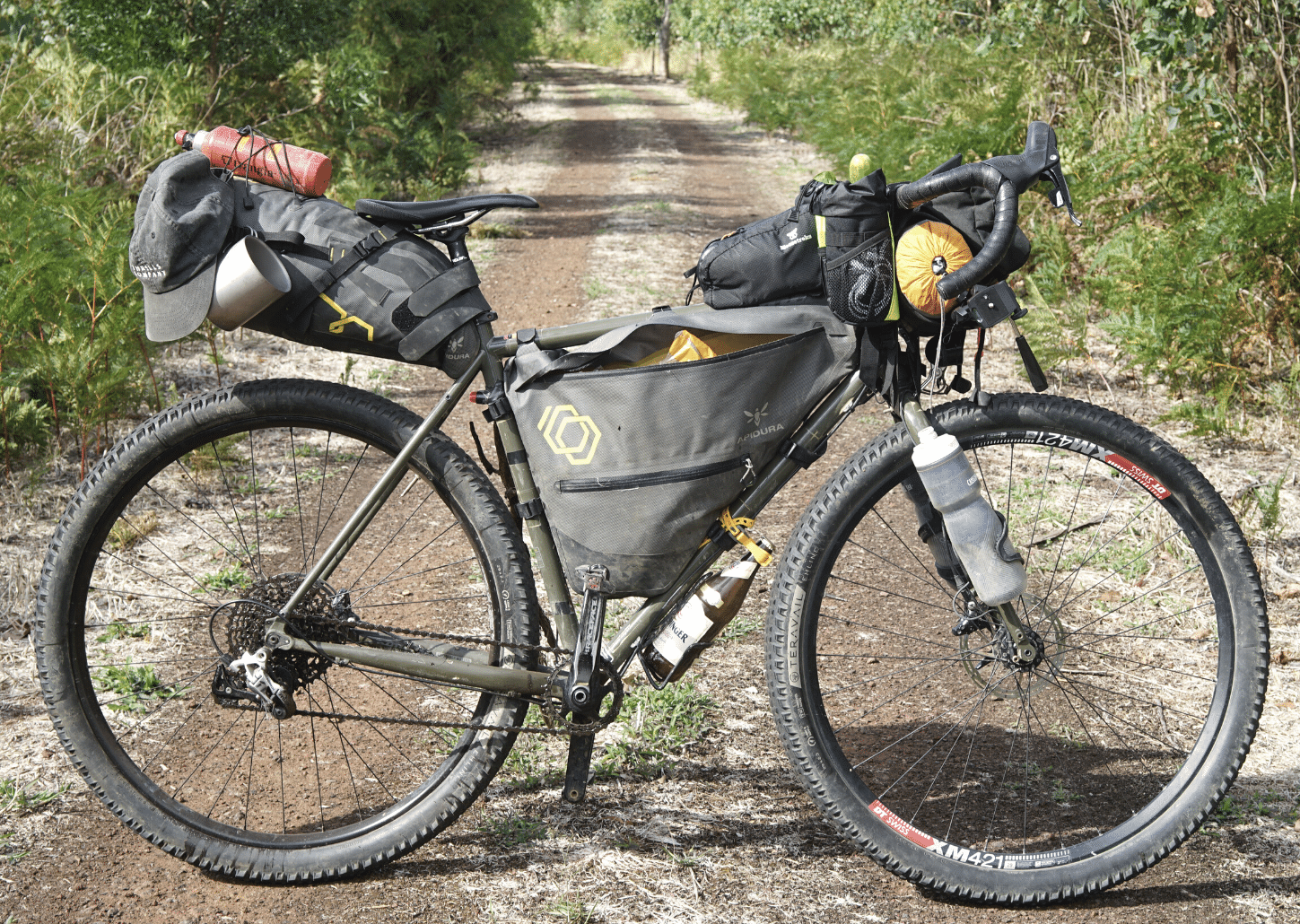
(A Classic All-Road Touring Bike with Modern Touches)
Price: $2,199 USD (about $3,446 AUD)
Bomb proof, rock solid, smooth and comfortable ride. with traditional touring bike components; Brooks Saddle, bar-end shifters and Deore groupset
Weight : 14kg (30.86 lbs)
Frame/Fork Material : Frame – Kona Cromoly Butted. Fork – Kona Project Two Cromoly Disc Touring
Groupset & Drivetrain : Shimano Deore, 26/36/48t crank and Shimano Deore 11-36t 10spd cassette
Gear Ratios : 19.90″ to 120.50″ (0.72 to 4.36 ratio)
Geometry (M) : Stack/Reach ratio – 1.56 chainstay 445mm – wheelbase 1,073mm – (steering) headtube angle 70.5 deg – trail 71mm – Fork offset/rake 50mm. Bottom bracket drop 72mm
Tires and Wheel Sizes (Tire Clearance) : 700c x 40mm With a max tire clearance 29×2.3″ (Check clearance with racks)
Pros
- Many mounting options
- Comfy, smooth and rock solid bike
- Clearance for 29×2.3″ tires
- Able to ride MTB sections
- Traditional bar-end shifters
- Rides well loaded or light
Cons
- A little sluggish when you need that extra speed for endurance bikepacking events
- Breaks have been known to freeze during winter
- Derailleur hanger is known to break slightly easier then others
- Have had issues with paint quality overtime
The Kona Sutra, my personal bike of choice, embodies the essence of a traditional touring bike while incorporating a 1x gravel drivetrain, a unique twist on the classic design. While the SE model maintains the frame of the Sutra LTD but stands out with its more versatile gear range. An especially notable feature is the stock Brooks saddle, a hallmark of comfort and quality.
On my own Kona Sutra LTD, I’ve managed to fit tires as large as 29×2.3″ without fenders, suggesting the potential for even broader options beyond the standard 700x40c Schwalbe Marathon Mondial tires that it usually sports.
The detailed specifications below are tailored to the touring bike variant of the Kona Sutra. However, if you’re intrigued by the prospect of a build more suited to off-road adventures, I highly recommend reading our review of the Kona Sutra LTD.
This bike is astonishingly versatile. I frequently use mine on challenging mountain bike trails, and it’s proven its worth time and again, effortlessly handling jumps and rugged terrain. Its performance as a commuter is equally impressive, proving itself capable of handling a diverse range of conditions.
In comparison to its peers, like the Trek 520 and Surly LHT, the Kona Sutra boasts superior specifications on paper. It features a full Deore groupset and includes bar-end shifters, which add a touch of traditional touring aesthetic.
A bombproof, fun machine that can take you anywhere. Offering a smooth and comfortable ride, it stands out as a rock-solid choice for both enthusiasts and serious cyclists alike.
Panorama Forillon

(A true Swiss Army knife for on-the-go travel bike)
Price: $2,399 CAD (about $2,747 AUD)
Weight : 13.15 kg (29 lbs)
Frame/Fork Material : Frame – REYNOLDS 525 Steel Fork – CUSTOM CR-MO 4130 Steel
Groupset & Drivetrain : 2×11 microSHIFT XLE, FSA – FSA OMEGA 2X MEGAEXO, 46/30T crank and MICROSHIFT XLE 11-42T cassette
Gear Ratios : 19.85″ to 111.81″ (0.71 to 4.18 ratio)
Geometry (M) : Stack/Reach ratio – 1.55 chainstay 455mm – wheelbase 1,050mm – (steering) headtube angle 71.8 deg – trail 67mm – Fork offset/rake 50mm. Bottom bracket drop 76mm
Tires and Wheel Sizes (Tire Clearance) : 700c x 44mm With a max tire clearance 700c x 50
The Forillon by Panorama Cycles is a steel all-road touring bike that combines a mid-component range with a budget-friendly price, making it an ideal choice for adventurers looking to explore the world. This bike is designed for efficient riding across various road types and maintains stability and ease of handling even when fully loaded with luggage.
At its core, the Forillon is a testament to strength and reliability, a theme that is evident in its choice of components. It features 36 spoke double-walled rims with reinforced eyelets, paired with robust 700x50mm tires, ensuring durability and stability on diverse terrains. The frame and fork of the Forillon are constructed from high-quality materials, including Reynolds 525 steel tubeset and 4130 steel, known for their resilience and long-lasting performance.
The Forillon stands out with its integrated kickstand plate and a plethora of mounting options, which include front and rear racks, fenders, and triple cage mounts on the fork and under the downtube. These features make it an excellent choice for riders who require a bike that can carry substantial gear on extended tours.
Other noteworthy aspects of the Forillon include its low bottom bracket, long chainstays, and a 2×11 drivetrain, all contributing to a comfortable and stable ride.
The bike also boasts mechanical BB7 brakes and bar-end shifters as part of its well-rounded build kit. Additionally, the frame and fork are treated with an anti-corrosion internal ED coating, enhancing the bike’s durability.
The Forillon is not just about functionality; it also has an aesthetic appeal. The frame graphics, inspired by topographic maps and created by Vancouver-based artists Pellvetica, add a unique touch to the bike’s design.
Offered in three sizes and weighing 29 pounds for the medium build, the Forillon is available at a retail price of $2,149 CAD (approximately $1,675 USD) through PanoramaCycles.com. This bike is a reliable, versatile, and stylish choice for those looking to embark on long-distance, all-road touring adventures around the globe.
Koga WorldTraveller

(The Ultimate Expedition Touring Bike)
Price: Approx $6,000
Weight : 17.5 kg (38.6 lbs)
Frame/Fork Material : Full Aluminium Build
Groupset & Drivetrain : Shimano Deore XT groupset or Rohloff drive belt
Geometry (M) : Stack/Reach ratio – 1.57 chainstay 477 mm – wheelbase 1,170 mm – (steering) headtube angle 69.5 deg – trail 82.4 mm – Fork offset/rake 50 mm. Bottom bracket drop 60 mm
Tires and Wheel Sizes (Tire Clearance) : Possibility to mount tires up to 72mm wide
Pros
- Can be packed up to 120 kg
- Super stiff for touring
- Built for durability & serviceability
- Includes mini-kick stand on the front rack and other accessories
- Life time warranty on the frame
- More standard touring equipment then most bikes
- Top of the line components
- Dynamo hub and lighting system as standard.
Cons
- Not the lightest touring bike on the block
- Quite expensive then most
The KOGA Worldtraveller series, recognized for its robust and versatile trekking bikes, is an ideal choice for all kinds of cycling trips. These bikes are designed to comfortably carry all your essentials, whether you’re gliding over smooth asphalt or tackling rugged gravel roads.
A notable aspect of the series is its unique alloy build. Despite the current popularity of steel touring bikes, the alloy construction of the Worldtraveller provides a solid and reliable alternative.
This bike remains stable and performs smoothly under a touring load, even when outfitted with sensible width tires. This combination of strength and smooth ride quality sets the Worldtraveller apart in the realm of long-distance touring bikes.
The series has been recently updated, with the new WorldTraveller model featuring a total load capacity of 180 kg. It can accommodate tires up to 72mm wide, enhancing its suitability for various terrains. The integrated rear carrier and new frame design contribute to improved rigidity and cycling performance.
For those interested in an electric version, the E-WorldTraveller includes the Bosch Smart System and a 750Wh battery. Customization is a key feature of the range, offered through the KOGA Signature programme.
The Worldtraveller range comprises several models:
- The standard WorldTraveller, a versatile trekking bike with numerous attachment points for luggage.
- The E-WorldTraveller, an electric variant with a Bosch motor and 750Wh battery.
- The E-WorldTraveller Suspension model, featuring a suspension fork with 100mm travel.
- The Worldtraveller Classic, a proven model known for its reliability.
- The Worldtraveller-S, offering choices in front forks, groupsets, and drive belts.
KOGA also offers extensive customization options through their Signature programme, allowing riders to tailor their bike to their preferences. Test rides are available to prospective buyers, showcasing the bike’s capabilities.
Tout Terrain Silkroad II 275
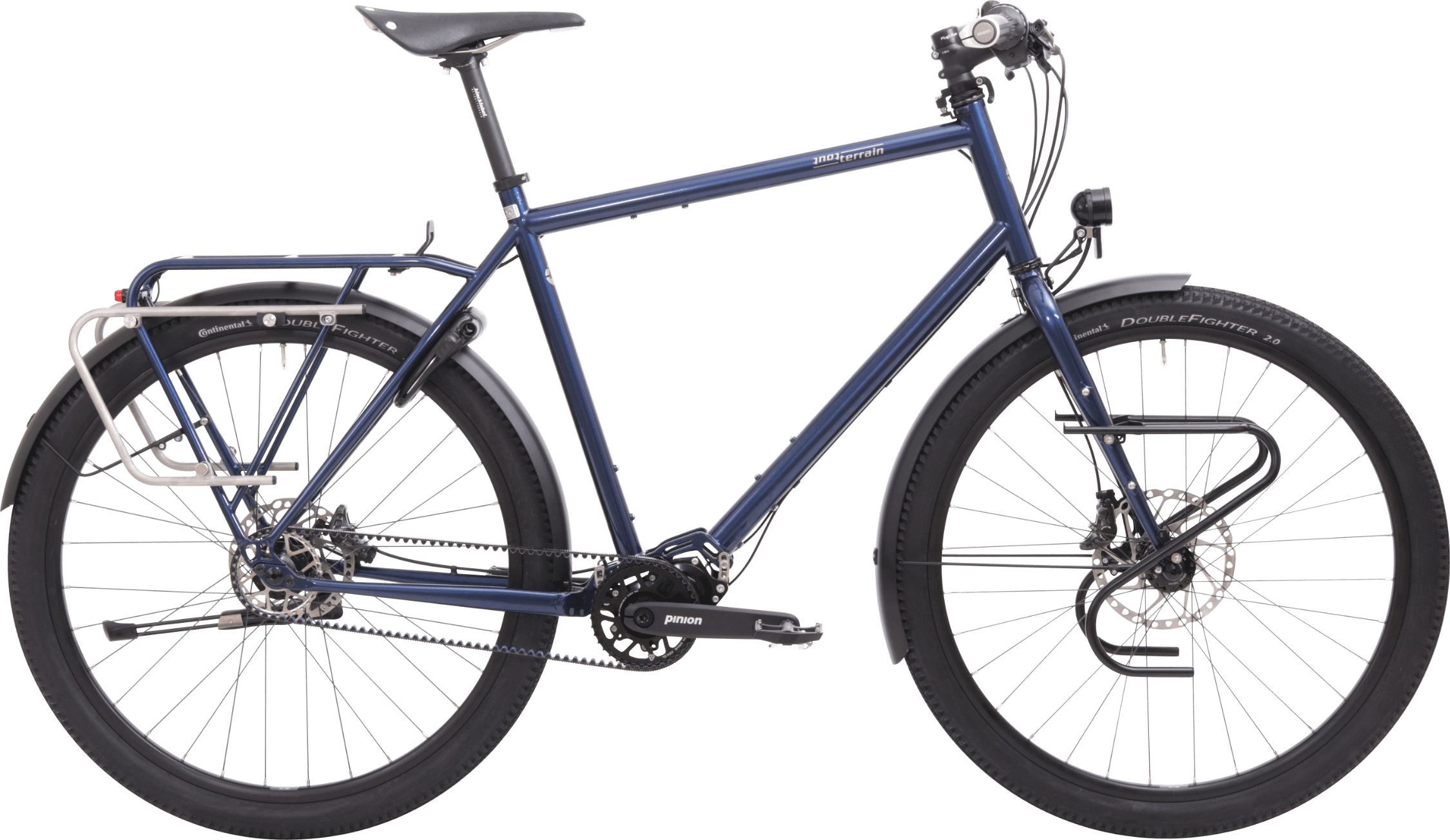
(A Steel Expedition Dream!)
Price: From €5,349 / $5,835 USD or $8,711 AUD
Weight : From 14 kg (30.09 lbs)
Frame/Fork Material : Full Steel Build
Groupset & Drivetrain : Rohloff drive belt
Geometry (M) : Stack/Reach ratio – 1.52 chainstay 455 mm – wheelbase 1,081 mm – (steering) headtube angle 70.5 deg – trail 73 mm – Fork offset/rake 47 mm. Bottom bracket drop 60 mm
Tires and Wheel Sizes (Tire Clearance) :
27.5″x2.0″ / With a max tire clearance 26″ x 2.0″ (50mm) with mudguard, 27.5″ x 2.0″ (50mm) with mudguard, 700C x 42 mm with mudguard
Pros
- Steel frame and oversized tubing create a robust structure
- Suitable for various terrains and heavy loads
- Standard with Rohloff hub or belt drive
- Customisable
Cons
- High-end components and features contribute to a higher price point
- Limited tire clearance
- Limited availability in certain regions
The Tout Terrain Silkroad is a high-end touring bike designed by the German company Tout Terrain. Known for their specialization in steel bikes for about 15 years, Tout Terrain’s Silkroad incorporates several innovative features and is built for durability and versatility.
The bike’s frame is made from steel tubes manufactured and welded in Taiwan, chosen for their ability to be easily repaired and modified. The Silkroad frames are among the first to pass rigorous safety testing, supporting a combined weight of rider, bike, and luggage up to 180kg/400lb. The bike uses oversized, thick-wall tubing to build a strong structure, which is beneficial for carrying front and rear luggage.
Key features include a steering limiter to prevent cable damage, an integrated steering lock to stabilize the bike when parked, and the option for either double-legged or rear-mounted kickstands. The Silkroad also boasts an integrated stainless steel rear rack designed to be indestructible and compatible with both regular panniers and the specially designed QL3 system panniers.
For power and lighting, the Silkroad uses 12mm thru-axles front and rear for maximum stiffness and alignment, and incorporates SL dynamo wiring in the fork for powering lights and USB chargers. The lighting system features Schmidt lights and a dynamo hub, and a Cinq Plug5 Plus USB charger integrated into the steerer tube.
The bike is equipped with a 14-speed Rohloff hub for the drive system, known for its reliability and efficiency, especially in challenging conditions. It also features a belt drive, preferred for its low maintenance requirements. Hydraulic disc brakes provide reliable stopping power, and the bike allows for the use of up to 203mm rotors.
The Silkroad offers different wheel size options, with 27.5″ being recommended due to the availability of high-quality tires. The bike is also fitted with Tout Terrain’s in-house “Black Label” components and a Selle Royal saddle from the Scientia range.
Bombtrack Arise Tour
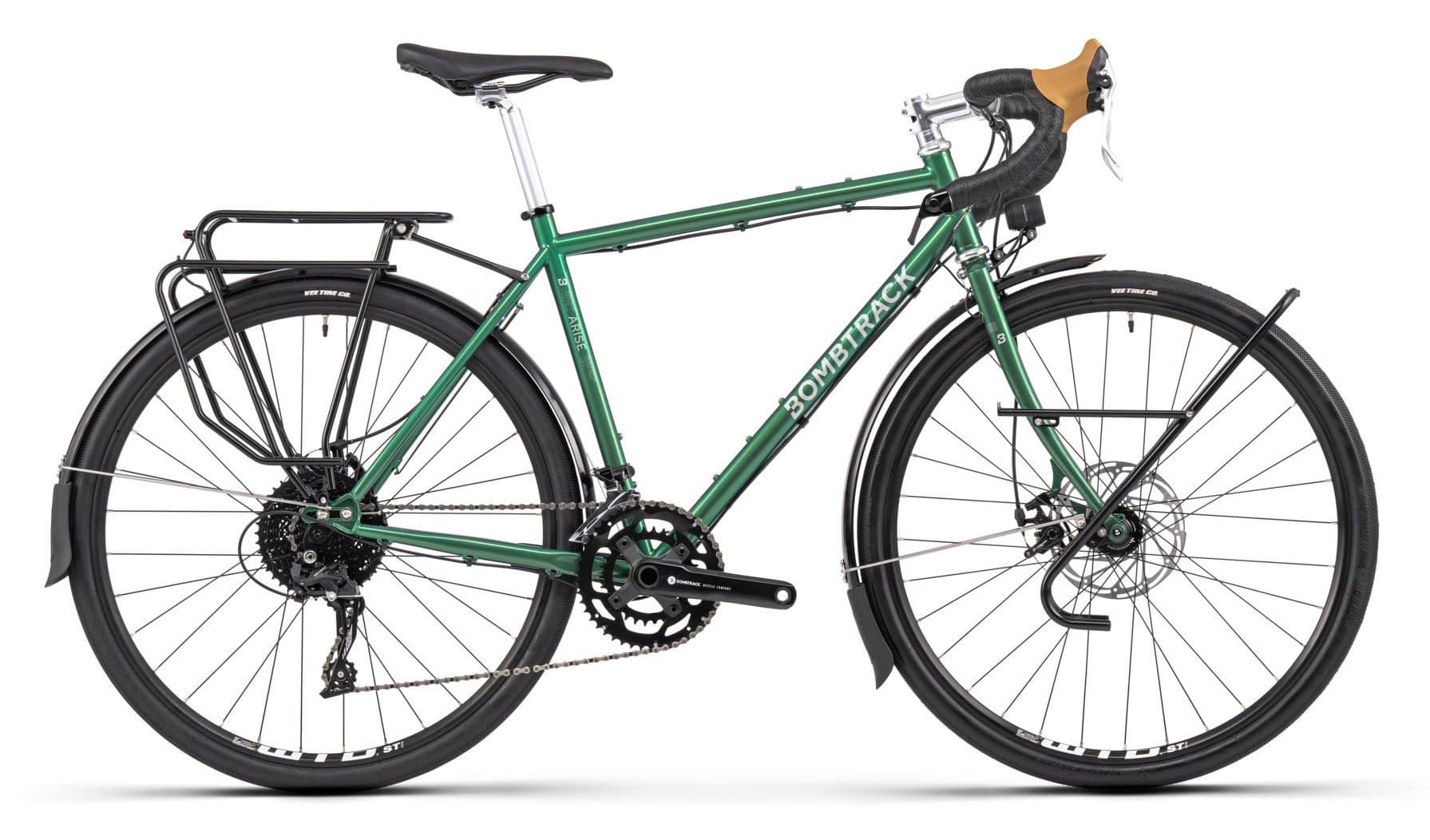
(Classic Touring Bike Aesthetics)
Price: $1,499 USD / $2,240 AUD (Estimates)
Weight : 14.7 kg (32.4 lbs)
Frame/Fork Material : Frame – 4130 double butted CrMo, heat-treated front triangle, TA sliding dropouts, rack/fender mounts. Fork – 4130 CrMo, TA, rack/fender mounts, internal hub dynamo cable routing
Groupset & Drivetrain : BOMBTRACK AMES forged aluminium crank and MICROSHIFT CS-H103 10-speed, 11 – 42T cassette
Gear Ratios : 19.62″ to 115.53″ (0.71 to 4.18 ratio)
Geometry (M) : Stack/Reach ratio 1.51 – chainstay 435mm – wheelbase 1,045 mm – (steering) headtube angle 70.5 deg – trail 68mm – Fork offset/rake 55mm. Bottom bracket drop 70mm
Tires and Wheel Sizes (Tire Clearance) : With a max tire clearance of 700C x 40C / 700C x 35C with fender
Pros
- Includes dynamo, quality Tubus racks, and lighting for an affortable price
- Microshift bar-end shifters give you the seamless and classic touring bike feel and look
- Affortable price tag
Cons
- Only has 32 spokes on wheels
- The mudguards are know for being low quality and breaking
- The frame length is a little short, for that extra stability when under a load, shorter then most touring bikes.
Offering a blend of traditional touring design and modern components, all wrapped in an eye-catching metallic green color that is sure to turn heads.
At its core, the Arise Tour features a double-butted steel frameset known for its adaptability and resilience. Enhancing its touring capabilities are the Tubus touring racks and aluminum fenders, designed to handle all your storage needs while protecting you from the elements. Illumination for those early starts or late finishes is provided by a full lighting system from KT and Supernova, ensuring safety and visibility in all conditions.
The bike’s transmission system is built for reliability over long distances. It features Microshift’s ultra-reliable bar end shifters and a 10-speed clutch mechanism. The wide-range 11 – 42T cassette and a subcompact 46 / 30 chainset make for a versatile and efficient setup, ideal for tackling various terrains with ease.
When it comes to braking, the Arise Tour relies on TRP Spyre C mechanical calipers, coupled with a 180 mm rotor upfront. This setup offers controlled and effective braking, particularly important on those thrilling long descents.
Every component on the Arise Tour has been meticulously selected for its proven reliability and durability. The goal is to let you focus on the joy of riding, rather than worrying about bike maintenance.
FalkenJagd Hoplit +
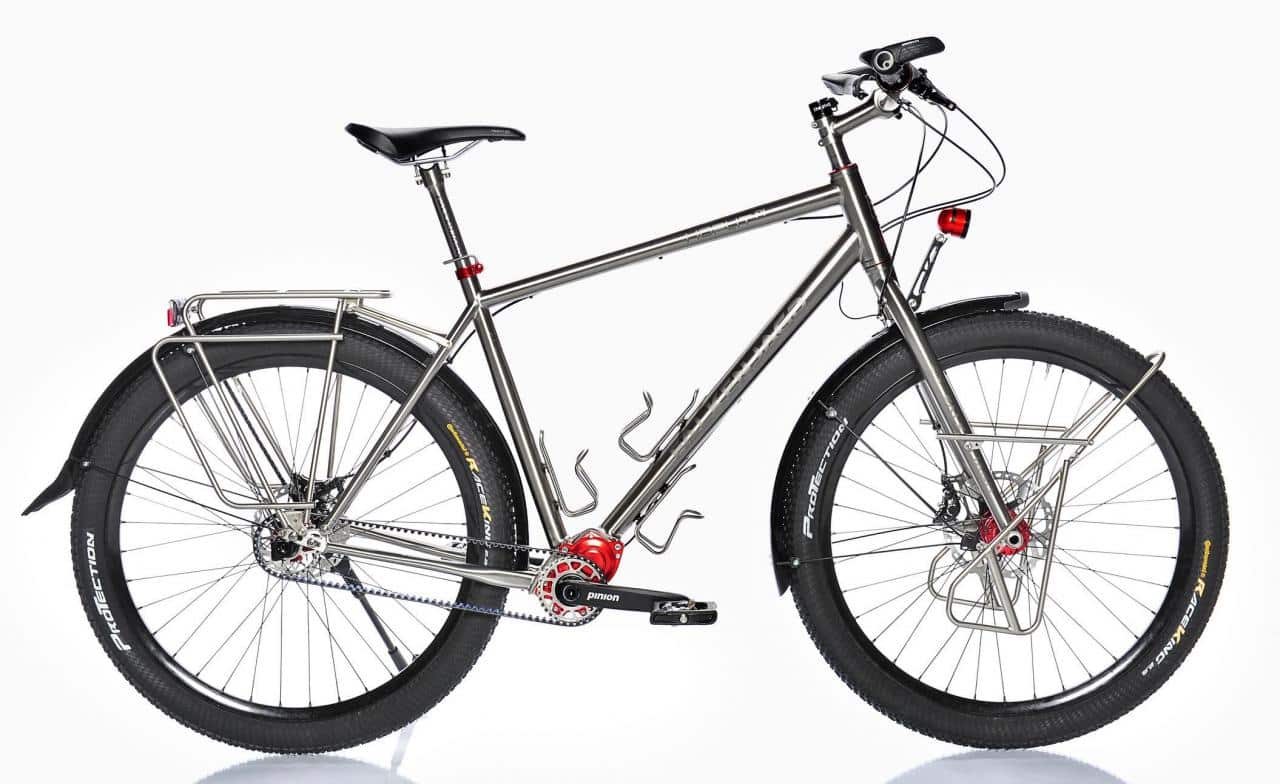
(Pinion Titanium Touring Bike)
Price: €6,798 / $7,415 USD / $11,000 AUD
Weight : 17 kg (37.5 lbs)
Frame/Fork Material : Full Titanium Build
Groupset & Drivetrain : Belt Drive
Tires and Wheel Sizes (Tire Clearance) :
WTB Trail Boss 27.5 x 2.35″ / Clearance for 650b x 3″ or 29er x 2.6″
Pros
- High quality components made of titanium and almost everything on the bike is tianium not just frame and fork
- Copes well on all surfaces
- Ultimate touring bike build!
Cons
- Very expensive
The Falkenjagd Hoplit PI Plus is a standout travel and expedition bike, designed for those who seek durability and reliability on long bike trips. Named after the elite warriors of antiquity, this bike lives up to its name with its robust build and high-quality components.
At the heart of the Hoplit PI Plus is its titanium frame, known for being extremely stable, scratch, and corrosion-resistant. The frame design, featuring a longer head tube and a slightly shorter top tube, facilitates a more upright sitting position, optimal for touring.
A key aspect of its design is the lower bottom bracket, which, by lowering the center of gravity, especially when carrying luggage, results in improved stability.
The bike’s rear triangle is notably sturdy, with chainstays designed for increased tire clearance and comfort. The rear dropouts are a technological marvel, allowing for longitudinally adjustable quick-release axles to optimize belt tension, and incorporating an integrated stand holder and a strap lock.
The Hoplit PI Plus is equipped with the Pinion P1.18 gear hub and a low-maintenance Gates CDX toothed belt, ensuring a smooth and reliable ride. It can accommodate either 28 or 27.5-inch wheels, offering flexibility depending on the rider’s preference for smooth running or damping.
This bike is an all-terrain champion, providing maximum comfort even under high payloads, thanks to its wide tires. It stands out for its high-quality titanium components, including the frame, fork, spacers, stem, handlebars, seatpost, luggage rack, and bottle cage.
Other features include a SON hub dynamo and lighting, a comfortable Brooks Cambium C17 saddle, Falkenjagd Titan Axios racks, Pitlock thru axles with theft protection, Magura MT7 4-piston disc brakes, and SKS Bluemels B65 mudguards.
The Hoplit PI Plus version extends its capabilities with its ability to take tire widths up to 3.0 inches (650B) and 2.6″ (29″). It boasts specially adapted chainstays and rear dropouts, which are adjustable in length for optimal belt tension. The bike’s design also ensures neatly laid cable pulls and flat mudguard and light mounts for a secure and aesthetic finish.
Trek 520 Disc
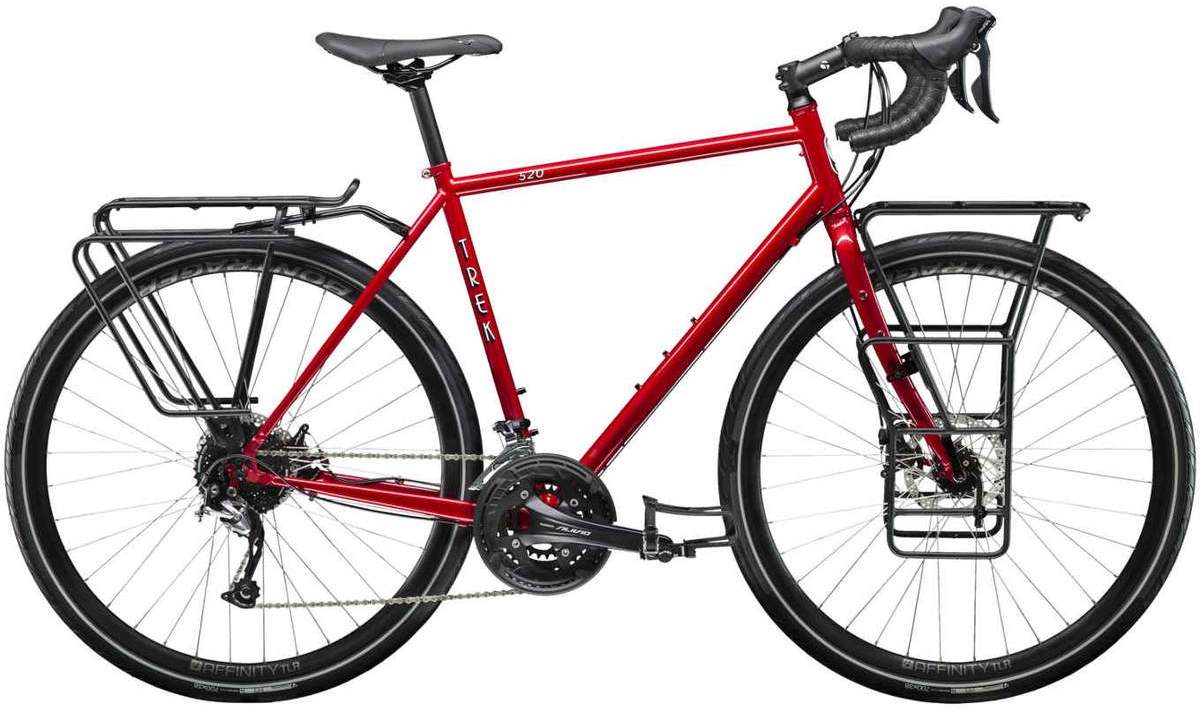
(The Longest-Running Touring Bike On The Market)
Price: $1,829.99 USD
Weight : 14.2 kg (31.31 lbs)
Frame/Fork Material : Steel frame / Alloy fork – Trek butted chromoly disc touring, 135×5 mm QR, Tire Clearance: 2″, Color: Diablo Red and Alloy disc touring fork, rack mounts, 100×5 mm ThruSkew.
Groupset & Drivetrain : Shimano Alivio with 48/36/26T crankset and 9-speed 11-36T cassette.
Gear Ratios Inches : 19.79″ to 119.81″ (0.72 to 4.36 ratio)
Geometry (M) : Stack/Reach ratio – 1.49 chainstay 450mm – wheelbase 1,048mm – (steering) headtube angle 71 deg – trail 65mm – Fork offset/rake 52mm. Bottom bracket drop 70mm
Tires and Wheel Sizes (Tire Clearance) :
700x38c / With a max tire clearance 29 x 2″
Pros
- One of the most budget friendly options in the list
- Steel frame is rock solid and feels great
- Perfectly comfortable touring bike
- Long chainstays and a slack head-tube angle offer a stable, comfortable, semi-upright riding position, suitable for both touring and commuting.
- 36-spokes
- Trek’s history of producing the 520 model since 1983 adds to the trust in the brand and model.
Cons
- Frame is however a little on the heavier side
- Stock pedals suck (order replacements if you consider this bike)
The Trek 520 stands as a testament to durability and adventure in Trek’s lineup, holding the title of their longest-running model. This true touring bike is designed for those who yearn for long journeys, offering a perfect blend of stability and comfort through its touring-specific geometry.
With a sturdy steel frame paired with an aluminum fork, the Trek 520 balances strength with practicality, weighing in at a manageable 31.4 lbs / 14.2 kg. It’s equipped with both front and rear racks, ready to handle all the gear you might need for your adventures, making it an ideal choice for the avid tourer.
Renowned for its solid build and reliable performance, the Trek 520 has been field-tested and established as an industry standard. It’s a bike that’s not just ready for your next touring adventure but is also built to last, promising at least a decade of enjoyable riding experiences.
However, it’s important to note that this bike demands regular maintenance to remain in peak condition, particularly in keeping the drivetrain clean to avoid gear hopping. But this small trade-off is worth the exceptional experience it offers, especially considering its versatile gearing range that makes conquering hills feel effortless.
For those looking for even more versatility, the 520 Grand is also an option to consider. Excelling in bikepacking, trail riding, and handling a mix of gravel and pavement, it expands the horizons of where the Trek 520 can take you.
Surly Disc Trucker
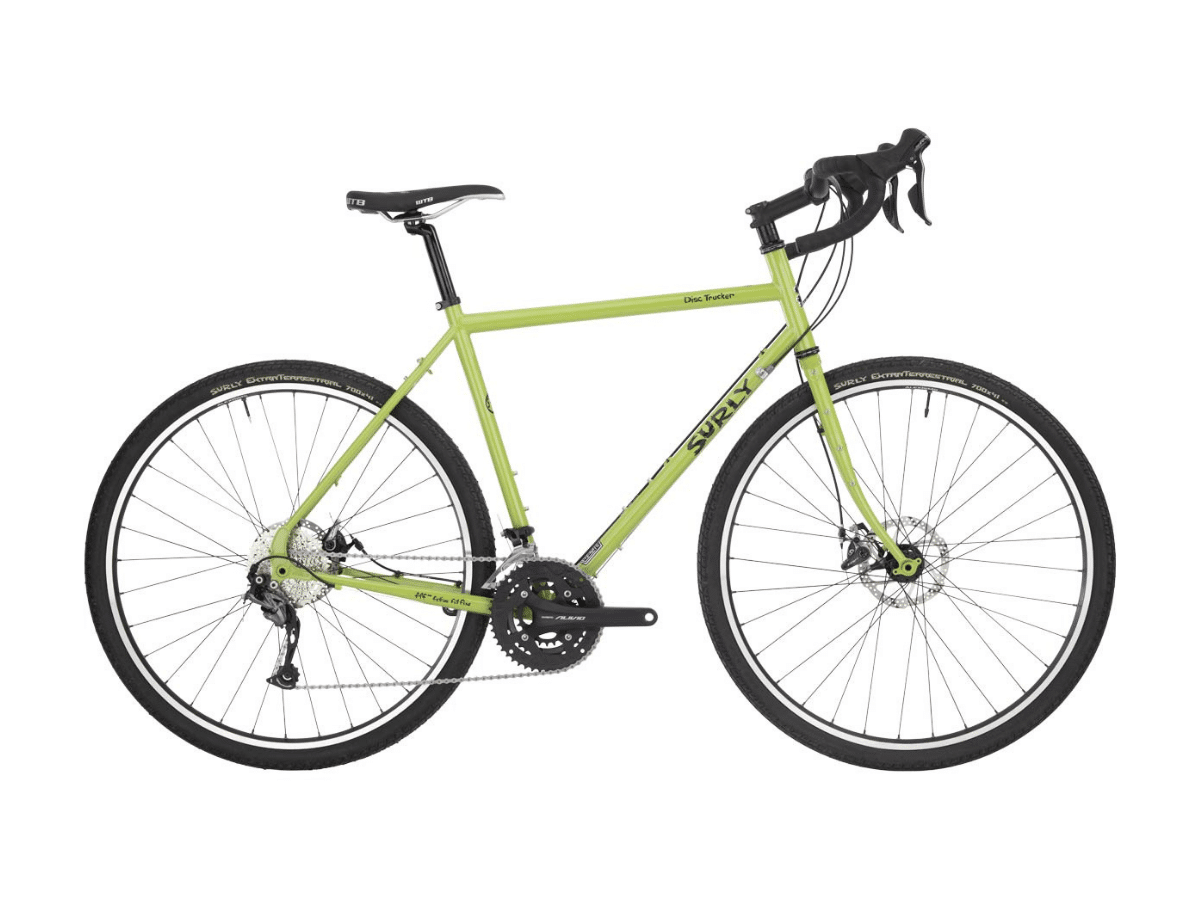
(A staple dirt tourer, just like its predecessor Long Haul Trucker)
Price: $1,749 USD or $2,600 AUD
Weight : 15.2 kg (33.5 lbs)
Frame/Fork Material : Frame – Surly Long Haul Trucker, 100% Surly 4130 CroMoly steel. Fork – Surly Long Haul Trucker, 4130 CroMoly, lugged and brazed
Groupset & Drivetrain : 3 x 9 Alivio, Sora drivetrain. Shimano Alivio 48x36x26t crankset and Shimano Alivio, 11-34t, 9 speed cassette.
Gear Ratios : 19.42″ to 111.40″ (0.76 to 4.36 ratio)
Geometry (M) : Stack/Reach 1.58 ratio – chainstay 450mm – wheelbase 1,076mm – (steering) headtube angle 71 deg – trail 57mm – Fork offset/rake 45mm. Bottom bracket drop 50mm
Tires and Wheel Sizes (Tire Clearance) : 26″ x 46mm With a max tire clearance for 26” x 2.1” tires with or without fenders, or 700c x 47mm with or without fenders
Pros
- The steel frame is robust
- 20-30mm taller frames and a 30mm taller handlebar, offer a more comfortable riding position.
- 10 frame sizes, catering to a wide range of rider heights
- Has the heritage of the LHT
Cons
- Toe overlap issues
- Not ideal for singletrack or technical trails due to its long wheelbase and less agile handling. (If you want to go off-road)
- No longer has the Shimano 3X10 bar-end shifters
- Smaller frame sizes have an increased standover
- The reduced chainstay length effects its capability as a touring bike
- It now has 32 spokes instead of 36
- No kickstand frame mounts
- A downgrade in drivetrain to Shimano Alivio from the previous Shimano XT
- The price has also increased
The Surly Disc Trucker, known for its reliability and no-nonsense approach, is a drop-bar steel touring bike. A staple among touring enthusiasts, this bike is recognized for its ability to handle long, loaded rides comfortably, though it doesn’t necessarily stand out in terms of its specifications.
Having personally ridden the Long Haul Trucker for thousands of kilometers, I can attest to its suitability as an excellent introduction to bicycle touring.
The 2021 model of the Disc Trucker however, sees some significant updates, including a taller frame and handlebar, additional tyre clearance, user-friendly STI shifters, and more mounting points, along with internal fork dynamo wiring and TRP Spyre brakes.
However, it loses some features like the Shimano 3X10 gearing and bar-end shifters. The Disc Trucker is well-suited for road travel and light off-road conditions but may not be the best choice for more technical or agile riding needs.
Decathlon Riverside Touring 900

(Best Value for Money Touring Bike You Can Buy!)
Price: £1,299.99 / $1,650 USD or $2,463 AUD
Weight : 17.1 kg or 37.7 lbs
Frame/Fork Material : triple-butted aluminium
Groupset & Drivetrain : Shimano XT Trekking groupset – 26-36-48 triple chainring – (11-36) cassette
Gear Ratios : 18″ to 80″ (0.64 to 2.91 ratio)
Geometry (M) : Stack/Reach ratio – 1.47 chainstay 458 mm – wheelbase 1,096mm – (steering) headtube angle 71.5 deg – Bottom bracket drop 54 mm
Tires and Wheel Sizes (Tire Clearance) :
28 x 1.75″ tires / With a max tire clearance up to 29 x 2.4” (estimated)
Pros
- Can carry up to 170 kg
- 33 mounting points for various accessories and luggage
- Equipped with Shimano Deore XT and a Brooks B17 saddle (High quality components.)
- Integrated Dynamo Hub
- Lifetime Warranty on frame, suspension, stem, handlebars, and rack.
- Insane value – priced competitively with comprehensive features.
Cons
- Heavier at 17kg, which may affect maneuverability and speed.
- Basic Pedals and Grips may need upgrading
- USB charger effective only at higher speeds
- Potential issues with exposed wiring for lights
- Despite having a mount, a kickstand is not included
- Steering lock mechanism to prevent over-rotation may take getting used to
The Riverside Touring 900, by Decathlon, is a highly robust and versatile touring bicycle ideal for multi-day trips, commuting, and carrying heavy loads. A bombproof touring bike, along with the bikepacking friendly Touring 920. These bikes are ready for adventure and for unbeatable value.
The 900’s key features include a strong and comfortable frame capable of carrying up to 170kg, internal cable routing, 33 mounting points for customization, and reliable Shimano Deore XT components. The bike is equipped with a Brooks B17 Imperial saddle, known for its comfort and durability, and TRP Spyke dual-piston mechanical disc brakes for reliable stopping power.
It also features a USB cycle-to-charge socket integrated into the stem for charging devices on the go, and robust aluminum mudguards. Before embarking on a major trip, it’s advisable to test the bike’s charger to ensure it meets your requirements. Consider whether you’ll need an extra power bank, as the charger requires extensive cycling to power your devices effectively. While it functions, its capacity is just sufficient for navigation purposes with the screen active.
However, it has a heavier frame at around 17kg. But if you don’t tour for speed that little extra weight shouldn’t bother you. And it comes with basic pedals and grips that might need upgrading for better comfort. But for the amount of touring bike you get you can’t beat it for value!
Vivente Gibb
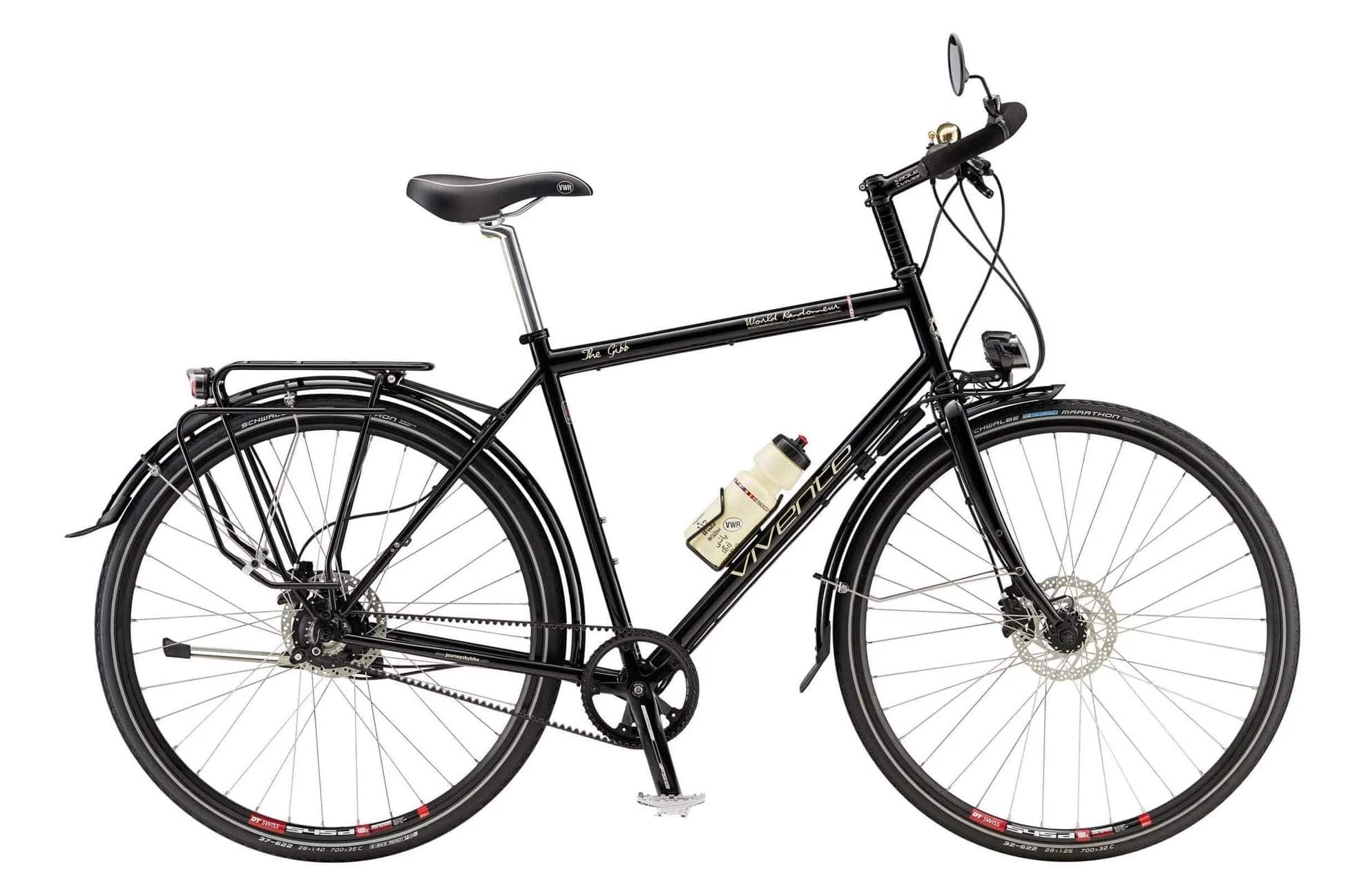
(Legendary Australian Touring / Expedition Bike)
Price: $6,600.00 AUD or $4,420 USD
Weight : 16.8kg (Estimated)
Frame/Fork Material : Full Steel Build – Double butted Cr-Mo touring frame and 1-1/8″ full Cr-Mo, threadless, mudguard, lowrider and electric cable mounts, through axle, steering stabiliser hook.
Groupset & Drivetrain : Andel crankset – BCD 130mm, 5 arm, 165/170/175mm, with FSA QR-1 self-extracting crank bolts. With Rohloff speedhub 500/14, 36H, CC DB, black, external transfer box, OEM axle plate, quick release
Gear Ratios : extra low gear ratios down to 15.9″ to 83.6″ with options in between or traditional 20.0″ to 105.2″
Geometry (M) : Chainstay 464 mm – wheelbase 1,087mm – (steering) headtube angle 71 deg – trail 67 mm – Bottom bracket drop 75 mm
Tires and Wheel Sizes:
Options for: 700C×40 (for road), 27.5 × 2.00 (for tracks), 27.5 × 2.80″ (all-rounders).
Pros
- Designed for minimal upkeep, ideal for long tours.
- Made from 4130 chromoly steel, offering stiffness and resilience, especially suitable for touring
- Superior mudguards, ergonomic handlebars, and intelligent dynamo light.
- Integrated rack and rear disc caliper, reducing the need for spacers and long bolts
- Comprehensive Tool and Spare Kit: Enhances self-sufficiency on long trips.
Cons
- One of the heavier touring bikes in this list
- Expensive
- Not the most beginner friendly bike – The comprehensive nature of the bike might be overwhelming for new cyclists.
The Vivente World Randonneur (VWR), particularly The Gibb model, stands as a pinnacle of touring and transportation bicycles in Australia. This bike, admired for its meticulous refinements over the years, now incorporates a series of desirable upgrades, culminating in a nearly perfect touring experience.
At its heart lies the Rohloff SpeedHub 500, a 14-speed hub gear known for its unparalleled range and reliability. While this hub adds to the cost and weight of the bike, its maintenance-free nature and durability make it a worthwhile investment for serious riders.
The bike’s 4130 chromoly steel frame ensures resilience and comfort, making it ideal for long rides. Its geometry is finely tuned for stability and ease of handling, enhancing the overall comfort during extended touring. The bike is also notable for its comprehensive tool and spare kit, ensuring riders are well-equipped for any situation.
The hydraulic disc brakes provide consistent stopping power, a crucial feature for safety and reliability. The dynamo-powered USB outlet is a thoughtful addition, allowing riders to charge devices on the go. While the bike may be somewhat daunting for beginners due to its complexity and the initial friction in new gears, its overall design is geared towards low maintenance and high performance.
Salsa Marrakesh
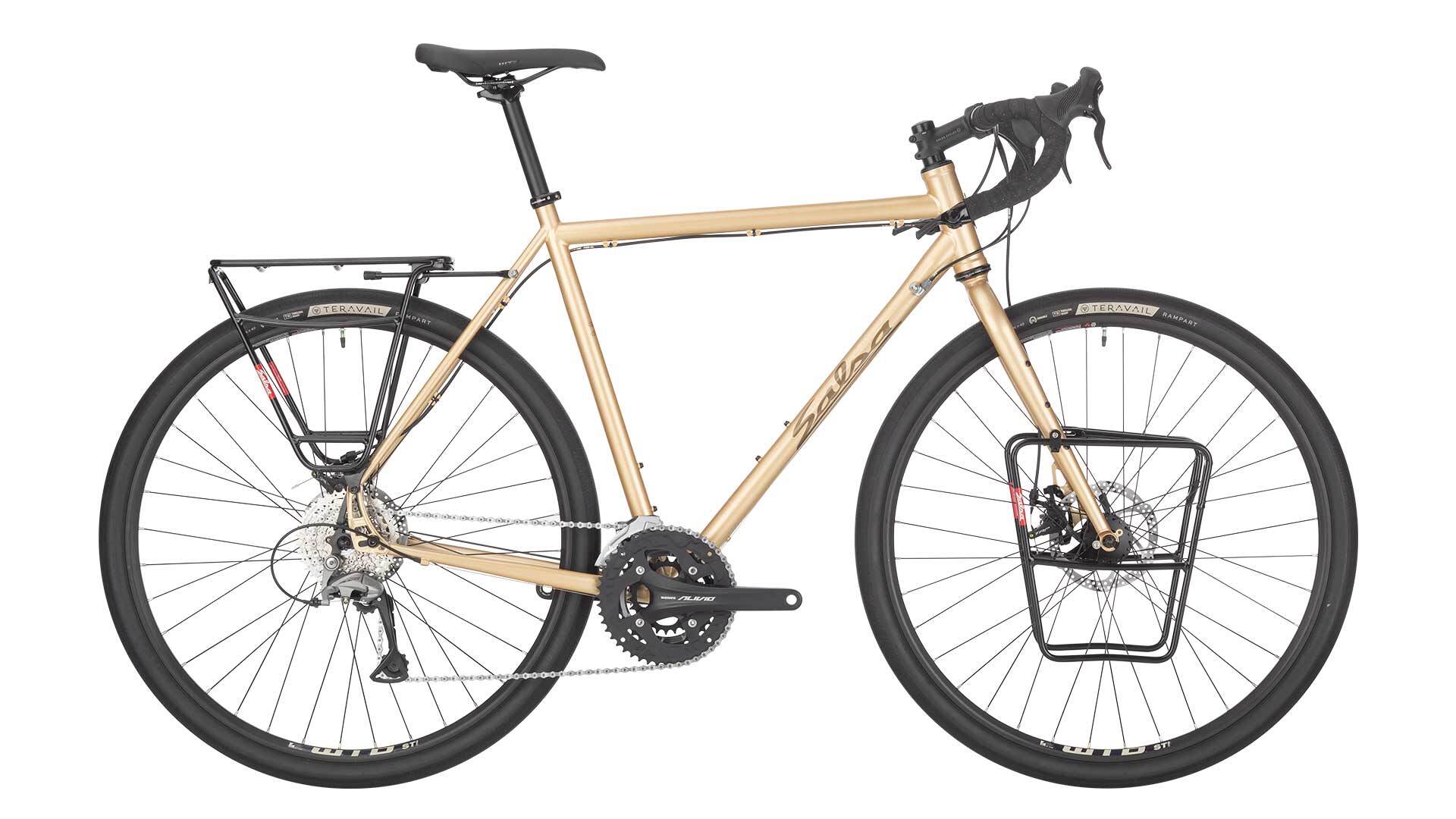
(Entry Level Traditional Steel Touring Bike Design)
Price: USD $2,049 (About $3,211 AUD)
Weight : 12.25 kg (27 lbs)
Frame/Fork Material : Full Steel Build – Marrakesh Triple Butted CroMoly – BB Standard: BSA, 68mm, Threaded – Tire Clearance: 50c – Color: Gold
Groupset & Drivetrain : Shimano Alivio – 11–36t, 9-speed cassette and 48/36/26t crank
Gear Ratios : 20″ to 121″ (0.72 to 4.36 ratio)
Geometry (55 cm) : Stack/Reach ratio – 1.55 chainstay 455 mm – wheelbase 1,055 mm – (steering) headtube angle 70.8 deg – trail 64 mm – Fork offset/rake 55 mm. Bottom bracket drop 77 mm
Tires and Wheel Sizes (Tire Clearance) :
Teravail Rampart 700c x 42 mm / With a max tire clearance 700c x 40mm tires with fenders and 29 x 2.0″ or Apparently you can run up to 27.5 x 2.6″ tires
Pros
- More then enough eyelets for storing gear
- Rohloff hub compatible drop out
- Very comfortable ride
- Traditional touring bikes design and aesthetics – bar-end shifters for example
Cons
- It comes with 42 mm tires but the minimum tire for fenders is 40 mm!
- Can only use the Salsa rear pannier rack due to how it attaches to the dropouts.
- The rear drop out swingplate is non-standard. A potential problem if it is damaged with limited access for parts
- The 2020 models in particular has paint chipping issues – even though it looks great
- Smaller frames may have limited space inside the frame for bikepacking frame bags and room for drink bottles
- Heel-striking is a potential issue on smaller frames
Made from a burly steel but heavy frame (not as heavy as some other bikes in this list) the Marrakesh offers a rock solid, stable and comfortable ride as you would expect in a touring bike.
With a dual capability for both off-road and on-road adventures. This bike is versatile enough for touring, commuting, or leisure riding, offering a comfortable experience across various terrains.
Despite its somewhat hefty build, the Marrakesh doesn’t compromise on maneuverability or performance. It comes equipped with front and rear racks, although fitting mudguards requires a slight reduction in tire width from the stock 42 mm tires to a maximum of 40mm.
The bike’s solid construction is further complemented by a reliable Shimano Alivio groupset, Microshift bar-end traditional touring bike shifters, and TRP Spyre-C disc brakes. Additionally, its wheels and tires are tubeless-ready, enhancing its off-road capabilities.
However, a notable concern for potential owners, particularly those with smaller frame sizes, is the chainstay design. The positioning of the rack is forward by about 20-30mm compared to other models, which impacts the bike’s handling, making it more akin to a shorter gravel bike when loaded.
This setup also raises the possibility of heel strike, a drawback that could affect the bike’s overall appeal as a touring option.
Genesis Tour De Fer
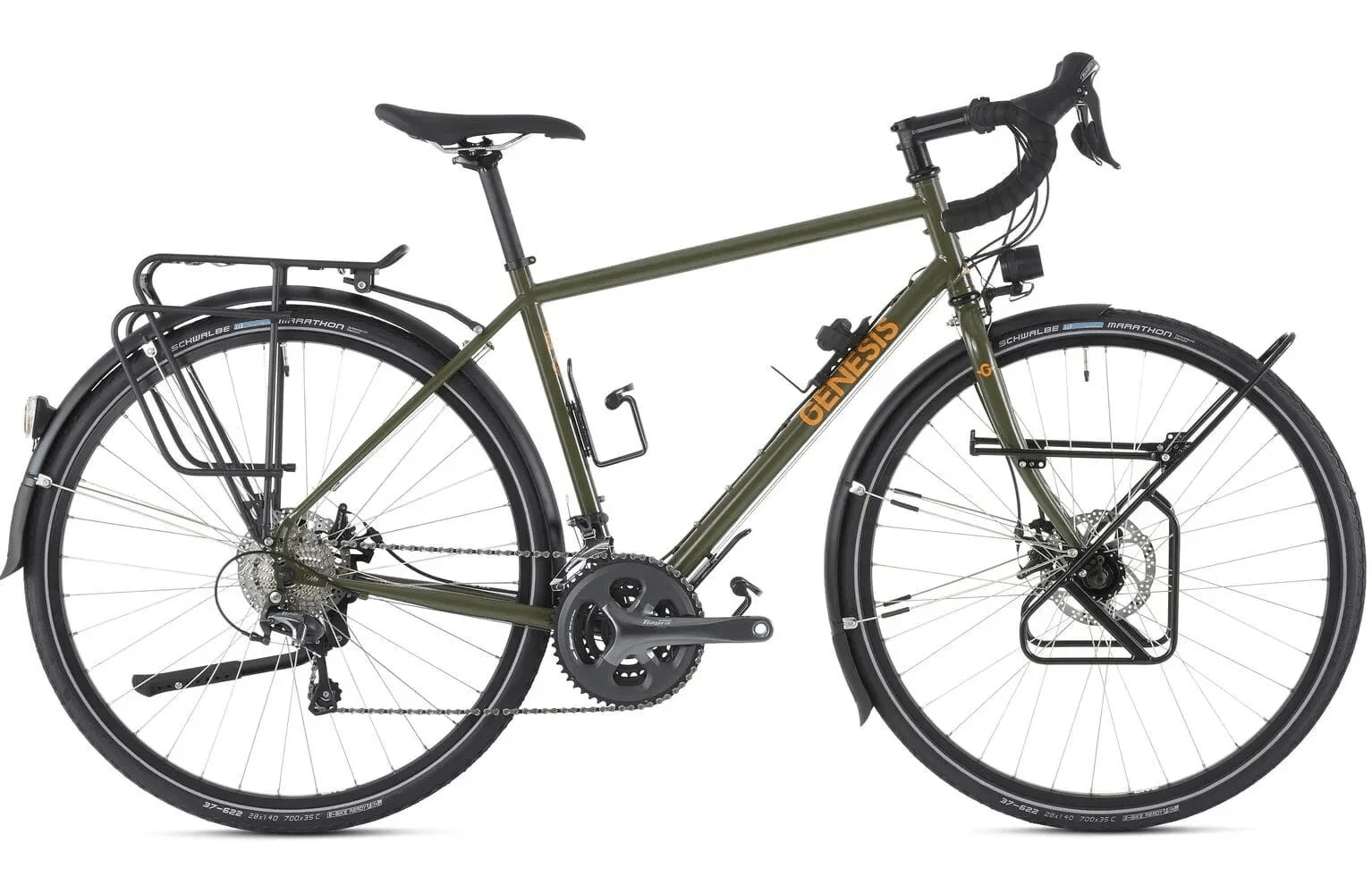
(The Most Budget Friendly Option In This List)
Price From: $1,590 + USD
Weight : 15.6 kg (34.40 lbs)
Frame/Fork Material : Full Steel Build
Groupset & Drivetrain : Shimano Tiagra
Geometry (M) : Stack/Reach ratio – 1.52 chainstay 455 mm – wheelbase 1,083mm – (steering) headtube angle 71 deg – trail 56 mm – Fork offset/rake 55 mm. Bottom bracket drop 75 mm
Tire Clearance:
700x35mm, with fenders, but the frame can accomodate 700x38mm without.
Pros
- 36 spoke wheels – strong for bicycle touring
- High quality Busch und Müller lights
- Well-balanced geometry ensures a stable yet responsive ride.
- Budget friendly option
Cons
- The Sunnywheel fenders might be a little narrow
- Limited tire clearance only up to 38 mm
- At 15.6kg, it might be considered heavy for some riders
- Not as capable off-road thanks to limited tire clearance
The UK-designed Genesis Tour de Fer 30, drawing inspiration from its sibling, the popular Croix de Fer, stands out as a remarkable blend of innovation and tradition in the world of touring bikes. This model is unique for its slightly longer build than most other touring bikes, providing an added level of stability and comfort for those extensive journeys.
But is it really a “Do-It-All Tourer?” With limited tire clearance, therefore limited off road capabilities it is better suited to traditional road only touring.
At the heart of the Tour de Fer 30 is the reliable Reynolds 725 steel frame, noted for its strength and relative lightness, making it a dependable companion for long-distance travels. The bike’s design is complemented by a chromoly steel fork with quick-release dropouts, further enhancing its durability and resilience.
A standout feature of this touring bike is its high-quality Busch und Müller lighting system, powered by a dynamo hub. These lights not only offer superior illumination for safer riding but also add a touch of sophistication to the bike’s overall design.
The shifting and drivetrain responsibilities are adeptly handled by Shimano’s Tiagra groupset, which includes a triple chainset offering a wide range of gears, ideal for tackling diverse terrains and steep inclines. The 10-speed cassette ensures low-maintenance, consistent performance, a crucial factor for long tours.
In terms of braking, the Tour de Fer 30 is equipped with TRP’s Spyre cable disc brakes, known for their consistent and sufficient stopping power. While they may not be as powerful as hydraulic brakes, their ease of maintenance, especially in remote locations, makes them a practical choice for touring.
The bike rides on robust Sun Ringlé Rhyno Lite rims and is fitted with the legendary Schwalbe Marathon tyres, renowned for their durability and puncture resistance. This combination ensures a smooth and reliable ride across various surfaces.
Finishing touches include Genesis branded components like a 27.2mm seatpost, a flared handlebar for comfortable handling, and a saddle designed for long rides. Practical features such as full-length mudguards, bottle cages, and spacious racks (including a Tubus Tara low-rider front rack and an AtranVelo Tour 365 rear rack) enhance its functionality for touring and commuting alike.
Co-Op Cycles ADV 1.1
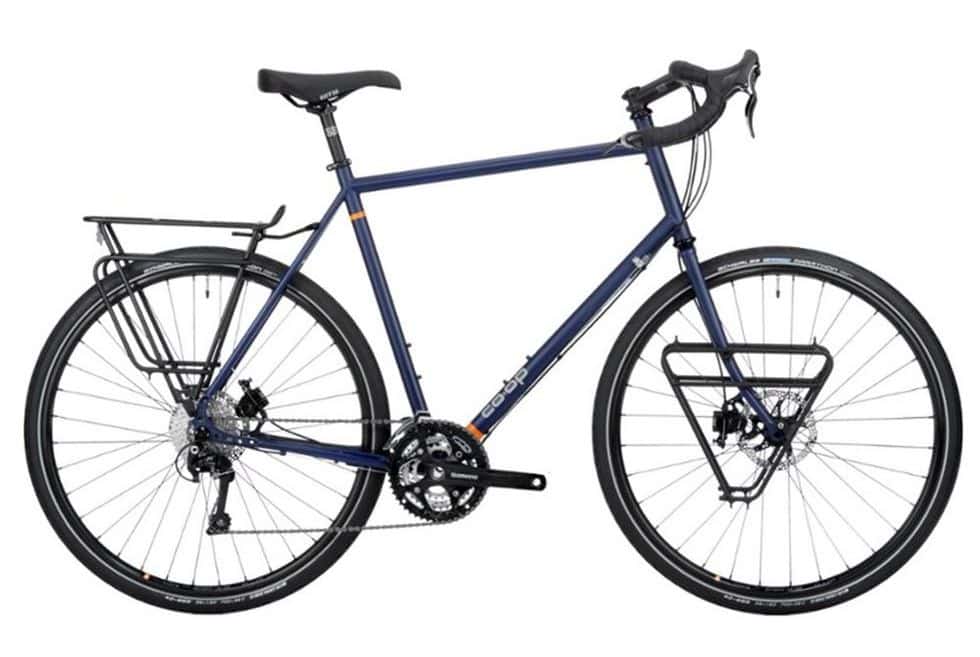
(The Most AFFORDABLE Touring Bike At the Time of Writing!)
Price: 1,699.00 NOW ONLY $1,358.93 USD
Weight : 13.61 kg (30 lbs)
Frame/Fork Material : Full Steel Build – Double-butted chromoly steel and Chromoly steel fork with 15mm thru-axle.
Groupset & Drivetrain : Shimano Deore, 48/36/26T crank and 10 speed 11-34T cassette.
Gear Ratios : 21″ to 120″
Geometry (M) : Stack/Reach ratio – 1.54 chainstay 455 mm – wheelbase 1,054mm – (steering) headtube angle 70.5 deg
Tires and Wheel Sizes (Tire Clearance) :
Schwalbe Marathon with puncture protection 700 x 38mm / With a max tire clearance up to 50mm
Pros
- Reliable Shimano Deore and Deore LX parts for the drivetrain
- Double-butted chromoly steel frame provides stability and a smooth ride
- Can support up to 300 lbs. including rider and gear (140 kg)
- Comes with spare spokes
Cons
- Getting on the heavier side but mid range weight compared to other bikes in this list.
- Tight clearance for fenders
- You could question the practicality of hydraulic disc brakes for touring bikes
The Co-op Cycles ADV 1.1 emerges as a robust and reliable touring bike, well-suited for long-distance journeys and heavy-duty touring. A very suitable bike for tackling steep inclines with heavy loads, which is what you want in a touring bike.
Its double-butted chromoly steel frame ensures a stable and comfortable ride, even under heavy loads, and the bike can support up to 300 lbs. The combination of a Shimano Deore crankset and Deore LX rear derailleur, along with the Tektro HY/RD hydraulic disc brakes, underscores its focus on durability and performance.
The bike is particularly noted for its excellent performance on long tours, with users reporting successful journeys over thousands of kilometers. It is equipped with puncture-resistant Schwalbe Marathon tires and comes with custom front and rear racks for carrying essential gear. An ultra-low gear option is also available, making it easier to navigate steep terrains.
However, some riders have noted the bike’s weight as a potential drawback, particularly when compared to lighter adventure options. There are some concerns about the practicality and maintenance of the hydraulic disc brakes for touring purposes.
Comparing These Bikes

Below, I’ve compiled a table featuring key information for each bike, making it easier for you to compare and decide which one best suits your needs. I hope this helps!
| Bikes | Price (USD/AUD approx.) | Weight | Frame/Fork Material | Groupset & Drivetrain | Gear Ratios | Geometry (M) | Tires and Wheel Sizes | Pros | Cons |
|---|---|---|---|---|---|---|---|---|---|
| Kona Sutra SE | $2,199 / $3,446 | 14kg (30.86 lbs) | Kona Cromoly Butted/Project Two Cromoly Disc Touring | Shimano Deore, 26/36/48t crank, 11-36t 10spd cassette | 19.90″ to 120.50″ | Stack/Reach 1.56, chainstay 445mm, wheelbase 1,073mm | 700c x 40mm, max tire clearance 29×2.3″ | Many mounting options, comfy, smooth ride | Sluggish at times, paint issues, derailleur hanger |
| Panorama Forillon | $2,399 CAD / $2,747 AUD | 13.15 kg (29 lbs) | REYNOLDS 525 Steel/CUSTOM CR-MO 4130 Steel | 2×11 microSHIFT XLE, FSA OMEGA 2X MEGAEXO, 46/30T | 19.85″ to 111.81″ | Stack/Reach 1.55, chainstay 455mm, wheelbase 1,050mm | 700c x 44mm, max tire clearance 700c x 50 | Steel build, various terrains, integrated kickstand | Limited tire clearance, potential issues with paint |
| Koga WorldTraveller | €2,599 / $4,317 AUD | 17.5 kg (38.6 lbs) | Full Aluminium Build | Shimano Deore XT or Rohloff drive belt | Not specified | Stack/Reach 1.57, chainstay 477mm, wheelbase 1,170mm | Up to 72mm wide | Stiff, durable, includes mini-kick stand | Heavy, expensive |
| Tout Terrain Silkroad II 275 | From €5,349 / $8,711 AUD | From 14 kg (30.09 lbs) | Full Steel Build | Rohloff drive belt | Not specified | Stack/Reach 1.52, chainstay 455mm, wheelbase 1,081mm | 27.5″x2.0″, max tire clearance 26″ x 2.0″/27.5″ x 2.0″ | Steel frame, suitable for various terrains | Limited tire clearance, high price, limited availability |
| Bombtrack Arise Tour | $1,499 USD / $2,240 AUD | 14.7 kg (32.4 lbs) | 4130 double butted CrMo/4130 CrMo | BOMBTRACK AMES forged aluminium, MICROSHIFT CS-H103 | 19.62″ to 115.53″ | Stack/Reach 1.51, chainstay 435mm, wheelbase 1,045mm | Max tire clearance 700C x 40C / 700C x 35C with fender | Affordable, classic touring aesthetics | Limited tire clearance, low quality mudguards |
| FalkenJagd Hoplit + | €6,798 / $11,000 AUD | 17 kg (37.5 lbs) | Full Titanium Build | Belt Drive | Not specified | Not specified | WTB Trail Boss 27.5 x 2.35″, Clearance for 650b x 3″ | High quality, titanium components, ultimate build | Very expensive |
| Trek 520 Disc | $1,829.99 USD | 14.2 kg (31.31 lbs) | Steel frame / Alloy fork | Shimano Alivio with 48/36/26T crankset, 9-speed 11-36T | 19.79″ to 119.81″ | Stack/Reach 1.49, chainstay 450mm, wheelbase 1,048mm | 700x38c, max tire clearance 29 x 2″ | Budget friendly, steel frame, comfortable | Heavy frame, stock pedals need replacement |
| Surly Disc Trucker | $1,749 USD / $2,600 AUD | 15.2 kg (33.5 lbs) | Surly Long Haul Trucker, 100% Surly 4130 CroMoly steel | 3 x 9 Alivio, Sora drivetrain | 19.42″ to 111.40″ | Stack/Reach 1.58, chainstay 450mm, wheelbase 1,076mm | 26″ x 46mm, max tire clearance for 26” x 2.1” | Robust steel frame, comfortable, heritage of LHT | Toe overlap issues, not ideal for technical trails |
| Decathlon Riverside Touring 900 | £1,299.99 / $2,463 AUD | 17.1 kg (37.7 lbs) | triple-butted aluminium | Shimano XT Trekking groupset | 18″ to 80″ | Stack/Reach 1.47, chainstay 458mm, wheelbase 1,096mm | 28 x 1.75″ tires, max tire clearance up to 29 x 2.4” | Affordable, strong frame, 33 mounting points | Heavier, basic pedals, USB charger effective at high speeds |
| Vivente Gibb | $6,600 AUD / $4,420 USD | 16.8kg (Estimated) | Full Steel Build – Double butted Cr-Mo | Andel crankset, Rohloff speedhub 500/14 | Not specified | Chainstay 464mm, wheelbase 1,087mm | Options for 700C×40, 27.5 × 2.00, 27.5 × 2.80″ | Minimal upkeep, steel build, comprehensive tool kit | Heavier, expensive, not beginner friendly |
| Salsa Marrakesh | USD $2,049 / $3,211 AUD | 12.25 kg (27 lbs) | Full Steel Build – Marrakesh Triple Butted CroMoly | Shimano Alivio – 11–36t, 9-speed cassette, 48/36/26t | 20″ to 121″ | Stack/Reach 1.55, chainstay 455mm, wheelbase 1,055mm | Teravail Rampart 700c x 42 mm, max tire clearance 700c x 40mm | Steel build, comfortable, Rohloff hub compatible | Heavier frame, limited space for frame bags |
| Genesis Tour De Fer | From $1,590 USD | 15.6 kg (34.40 lbs) | Full Steel Build | Shimano Tiagra | Not specified | Stack/Reach 1.52, chainstay 455mm, wheelbase 1,083mm | 700x35mm, with fenders, frame can accommodate 700x38mm | Budget friendly, well-balanced, high quality lights | Narrow fenders, limited tire clearance, heavy |
| Co-Op Cycles ADV 1.1 | $1,699 / $1,358.93 USD | 13.61 kg (30 lbs) | Full Steel Build – Double-butted chromoly steel | Shimano Deore, 48/36/26T crank, 10 speed 11-34T | 21″ to 120″ | Stack/Reach 1.54, chainstay 455mm, wheelbase 1,054mm | Schwalbe Marathon with puncture protection 700 x 38mm | Affordable, double-butted steel, reliable drivetrain | Heavier side, tight clearance for fenders |
Why You Should Trust Cycle Travel Overload’s Advice
Hey I’m Codey Orgill and have been exploring this world by bicycle for over 8 years now! I have a long history with touring bikes, first being introduced to the world of bicycle travel with a classic Novara Randonee touring bike, then a Surly Long Haul Trucker and I now ride the Kona Sutra Touring Bike.
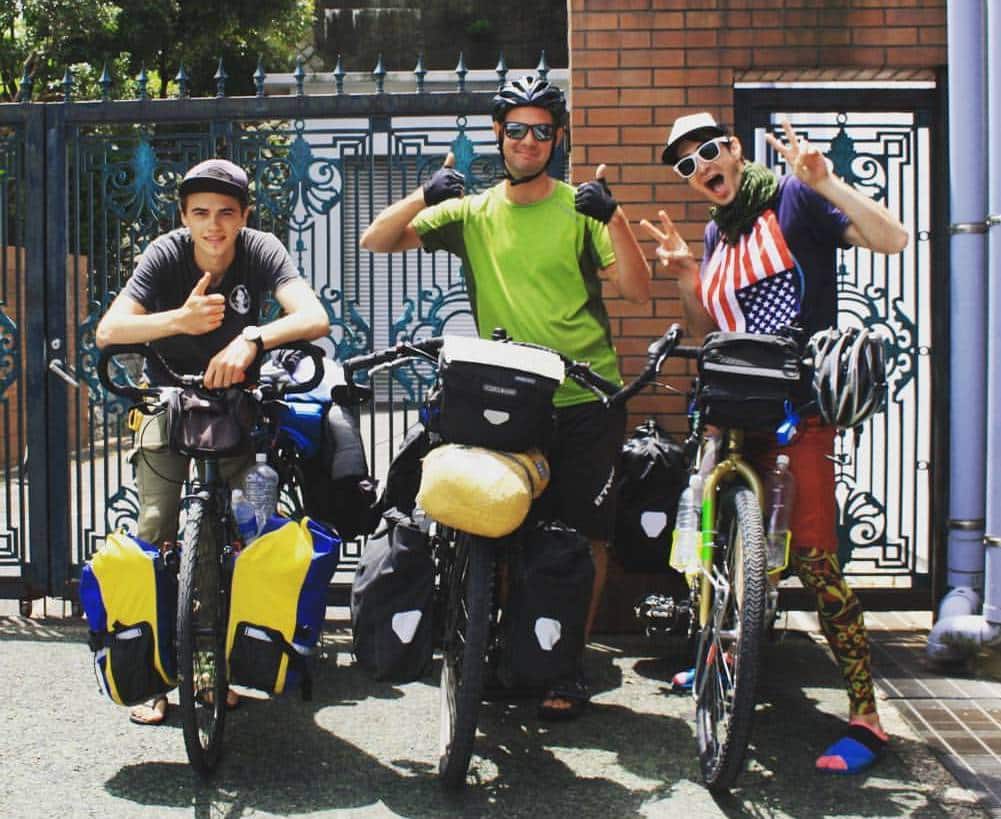
I have ridden my bikes across 10+ countries so far and a lot of trips where I live here in Australia! Lover of bikes and so passionate about researching, riding, and writing 🙂 about adventure-focused bicycles. That’s why I started this blog! Have helped over 1 million people find, compare, and decide on their dream adventure bike! Nothing means more to me than getting more people out into the world on two wheels!
What Makes A Good Touring Bike? Criteria For Choosing These Bikes
First I wanted to focus on mostly more traditional touring bikes in this list. As I plan to put together a updated guide for off-road touring bikes better suited for bikepacking type adventures.
Comfortable and Stable Geometry & Design: A top priority was the bike’s geometry. We looked for models with a long wheelbase, (average touring bike wheelbase: 1050 to 1070mm) and chainstay to ensure sufficient heel clearance during pedaling, (average touring bike chainstay: 445 to 470mm) and to accommodate rear panniers. The ideal geometry also contributes to a stable center of gravity, enhancing balance and creating a smoother ride. Additionally, a front center of (around 600 millimeters) is ideal for toe clearance and compatibility with front panniers, a typical setup for world-spanning adventures. For predictability and more stable steering a 60 to 70 mm trail is ideal!
Upright Riding Position: An upright riding position is crucial for comfort during long tours. We sought a stack-to-reach ratio of about 1.5 or higher to avoid a hunched-over posture, reducing back strain over extended periods.
Gear Ratio: The gear range was another vital factor. We looked for bikes with a broad spectrum of gears, especially low-end ratios for climbing with a heavy setup. Ideal bikes offer gearing as low as 18 inches for steep ascents and up to 120 inches for comfortable descents, accommodating various touring conditions. However if you are doing lighter touring and commuting, typically up to a 25 inch low gear is a pass, but not for fully load adventures.
Wheels and Components: Quality components are non-negotiable for durability and performance. We ensured that each bike had robust components unlikely to fail during extended tours. Wheel strength is vital, so we preferred bikes with a high spoke count, ideally 36 spokes to support the weight of a fully loaded touring setup. But some of the lighter touring bikes or not so good build quality bikes may have 32 spokes which isn’t ideal.
Weight Considerations: While weight is a factor, it’s less critical in touring bikes. Most selected bikes weigh around 13 to 15 kilograms or heavier, standard for this category. With added gear, this weight increases significantly, but our focus was more on reliability than lightness.
Other Considerations: The bike’s load capacity is a pivotal feature, with higher capacities being more advantageous. Ideally, a robust touring bike should be able to support a total weight ranging from 130 to 180 kg. Additionally, factors like frame stiffness and the configuration of the kickstand are also important considerations for these types of bikes.
What Are Touring Bikes? The Different Types of Touring Bikes
Touring bikes can be broadly categorised into four distinct types, each tailored to different touring needs and preferences. While there are even more nuances within these categories, this classification provides a solid foundation for understanding the diverse range of touring bikes available in the market.
Traditional or Classic Touring Bikes
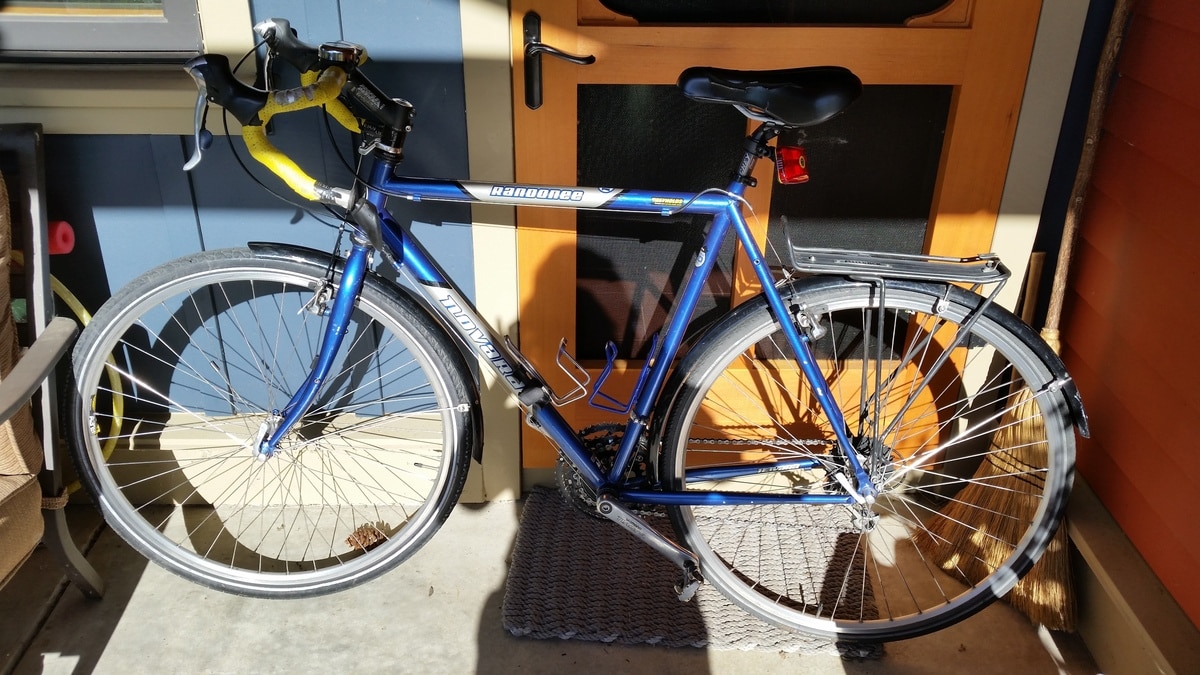
Traditional or classic touring bikes are built to be tough and withstand the rigors of long, continuous cycling over days, months, or even years. Unlike road bikes, these are designed with a focus on durability and stability. Typically made from steel, these bikes feature an upright geometry, longer chainstays, and are often equipped with fenders and a rear rack for panniers. The wheels are usually 700c with a high spoke count (32 or 36-hole) to endure the demands of bike touring. While classic touring bikes traditionally had rim brakes, mechanical disc brakes are becoming more common in this category. Both flat and drop bars are seen on these bikes, which often have a vintage look, as their design emphasizes functionality and longevity over aesthetic changes.
When discussing traditional touring bikes, the Novara Randonee instantly springs to mind as the quintessential example. With its bar-end shifters, classic steel frame, and comfortable touring geometry, it embodies everything a touring bike should be. This bike holds a special place in my heart as my first introduction to the world of bicycle travel. I’m eternally grateful to both the bike and Eric, the generous legend who gifted it to me. Thanks, mate!
Expedition Touring Bikes
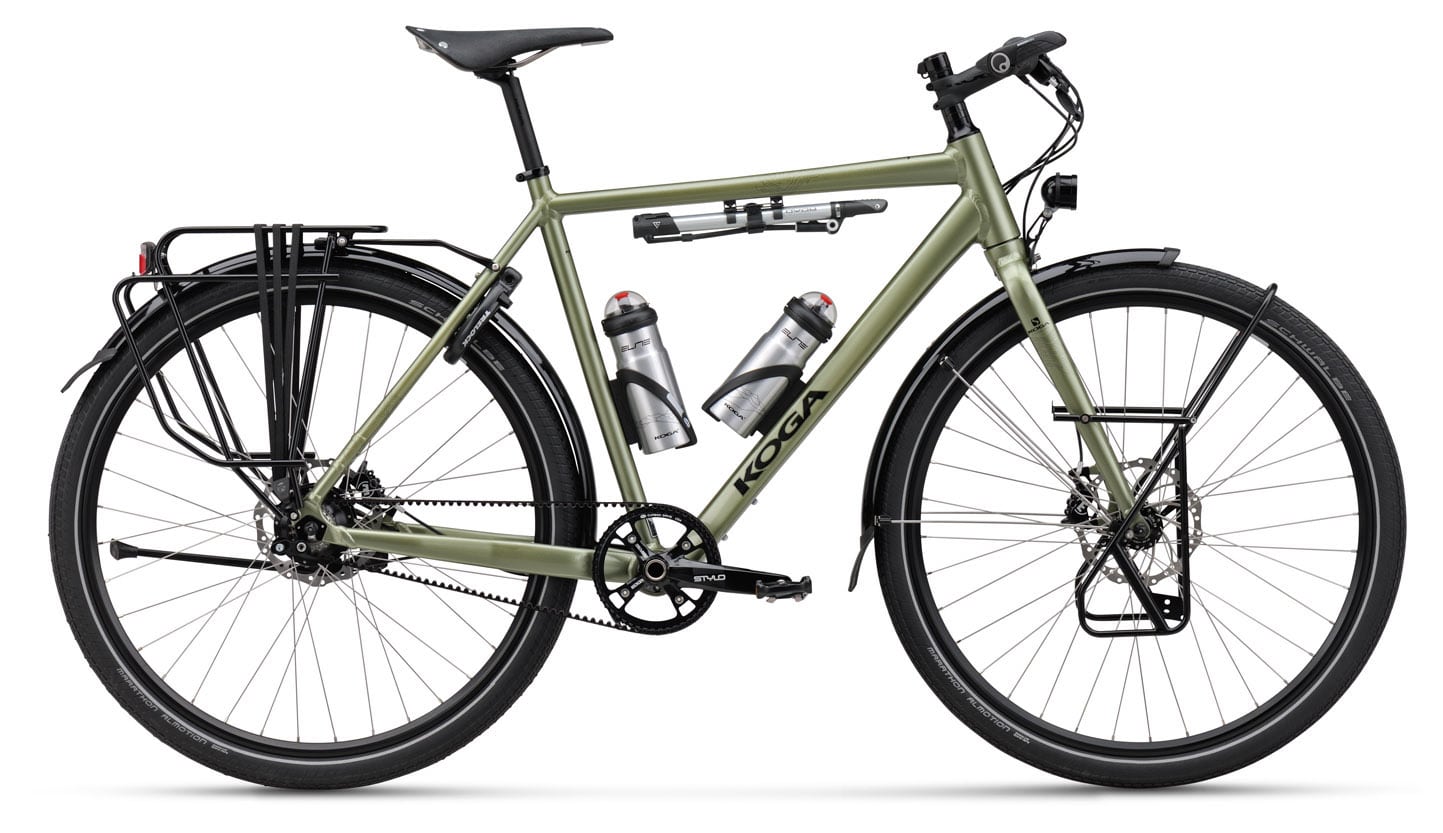
Expedition touring bikes are designed for epic, long-duration trips, such as around-the-world adventures. Made primarily from steel for robustness and ease of repair, these bikes typically feature 26-inch wheels and rim brakes. The choice of these components is strategic, as they make it easier to repair and replace parts, even in remote corners of the globe. These bikes are built for resilience and are capable of carrying all essentials for extended journeys, making them a top choice for serious long-term touring enthusiasts.
These bikes are quite similar to traditional touring bikes but offer even more adventure focused components and parts as standard like kick stands, Dynamo hubs and light setups, and trekking bars or flat swept back alt bars are often more common on these bikes for that extra comfort in the saddle. The Koga WorldTraveller is a perfect example of this category of bike.
Adventure Touring Bikes
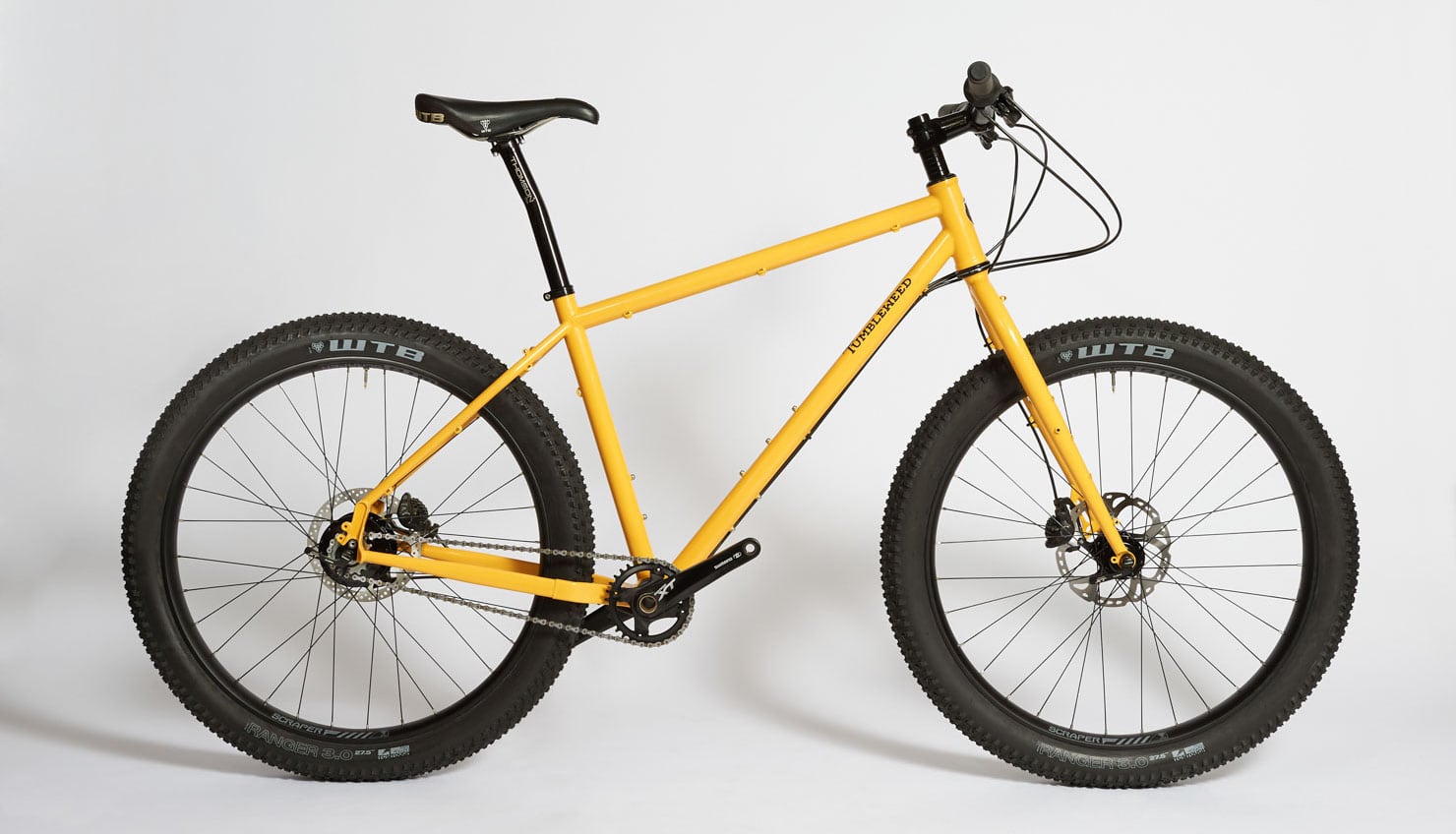
Adventure touring bikes or off-road touring bikes are crafted for rougher terrains, such as loose dirt, single tracks, and off-road wilderness paths, making them ideal for exploring less-traveled roads. These bikes are essentially a blend of road and mountain bikes. They usually come with drop bars and either mechanical or hydraulic disc brakes, offering strong stopping power for diverse conditions. Adventure bikes can accommodate a variety of wheel sizes and have clearance for wider tires. Many models are also equipped to handle dropper posts, adding to their versatility for different types of terrain.
For example, the Tumbleweed Prospector is engineered for supreme reliability and performance in rugged terrains. Its design eschews trendy materials for durability, particularly excelling with the Rohloff SPEEDHUB, an internally geared drivetrain known for its resilience in diverse conditions, from deserts to snowy mountains. Unique features like the Phil Wood eccentric bottom bracket and custom cast dropouts, coupled with a design focused on maximum mud and tire clearance, make the Prospector a top choice for adventurous global expeditions.
Light Touring or Gravel Touring Bikes
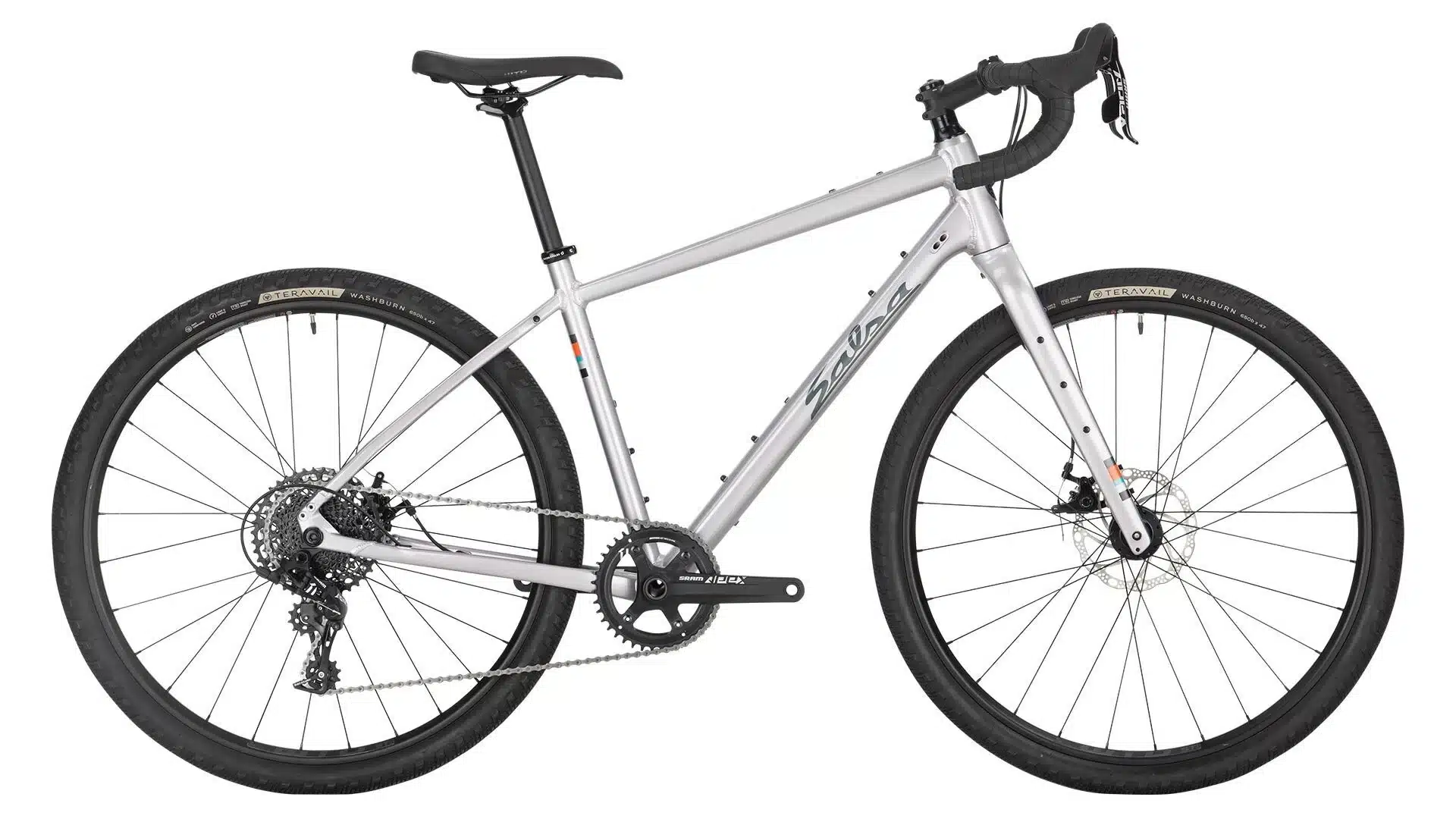
Light touring or gravel touring bikes are similar to gravel bikes in that they offer the flexibility for both on-road and off-road use, but with the added functionality of eyelets for attaching racks. They are designed for carrying lighter loads and are more suited for shorter bike tours or bikepacking trips. Generally lighter in weight than traditional touring bikes, they provide a versatile and adaptable solution for cyclists who prefer a mix of on and off-road experiences. These bikes are often interchangeable with gravel bikes, focusing on a balance between lightness, flexibility, and durability.
In this category, the distinction between gravel and touring bikes becomes more nuanced, existing on a spectrum. Some gravel bikes are adeptly equipped for touring and off-road adventures, thanks to their tire clearance, touring-inspired geometry, and build quality. Others, however, are better suited for lightweight touring, with their capabilities leaning more towards smooth roads or light gravel paths due to certain limitations in design and gearing. This diversity means that while some models excel in rugged conditions, others are ideal for less demanding journeys. A good example of a lighter touring bike would be something like the Fuji Touring Disc or the Salsa Journeyer.
How To Choose A Touring Bike
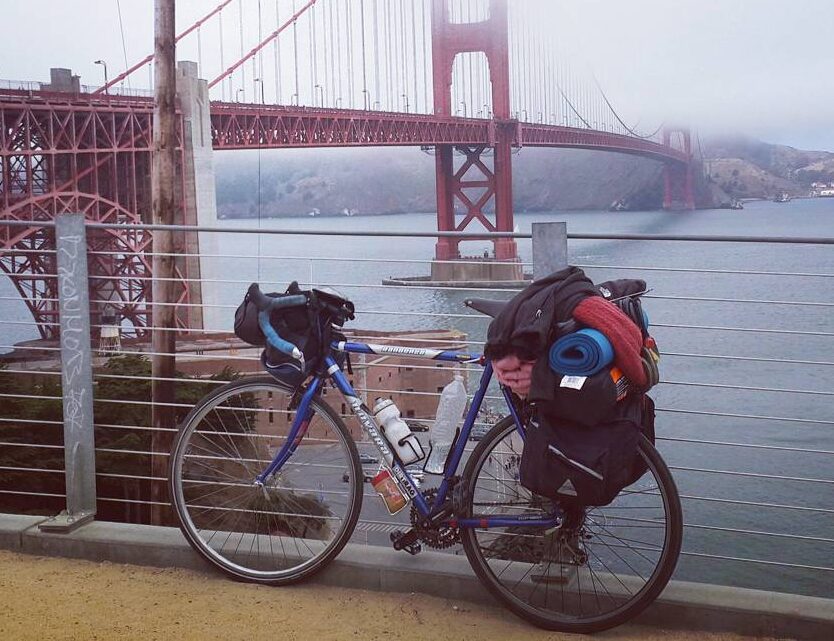
When it comes to choosing the perfect touring bike, understanding your specific needs and priorities is key to narrowing down your options and making an informed buying decision. Every touring bike offers a unique combination of features, and what works for one cyclist might not suit another. By focusing on what is most important for your touring experience, you can filter through the plethora of choices and find a bike that aligns perfectly with your requirements.
1. Prioritize Your Touring Environment: Are you planning to ride mostly on smooth roads, rugged trails, or a combination of both? The terrain you expect to encounter is a primary factor in determining the type of touring bike you need. For instance, if off-road adventures are your main focus, a bike with sturdy tires and a durable frame, like an adventure touring bike, will serve you well. On the other hand, if you’re sticking to paved roads, a traditional touring bike with smoother tires would be more appropriate.
2. Comfort vs. Performance: Long-distance touring demands comfort, especially if you’re spending several hours a day on the bike. Consider bikes with a geometry that offers an upright riding position, reducing strain on your back and shoulders. However, if speed and performance are more important to you, a bike with a more aggressive geometry might be preferable.
3. Load Capacity and Accessories: Assess how much gear you need to carry. If you’re planning a self-supported tour with lots of luggage, look for a bike with a high load capacity, robust racks, and multiple mounting points. Conversely, if you prefer light touring with minimal gear, a bike with fewer rack options but a lighter frame might be better.
4. Maintenance and Durability: If you’re touring in remote areas, consider the ease of repair and maintenance of the bike. Bikes with simpler, more robust components are easier to fix on the road. The bike’s durability also plays a crucial role, especially in challenging conditions.
5. Budget Considerations: Set a realistic budget and stick to it. Higher-priced bikes usually offer better quality and more features, but there are also great mid-range and budget options that can meet your needs effectively.
Panniers for Touring Bikes
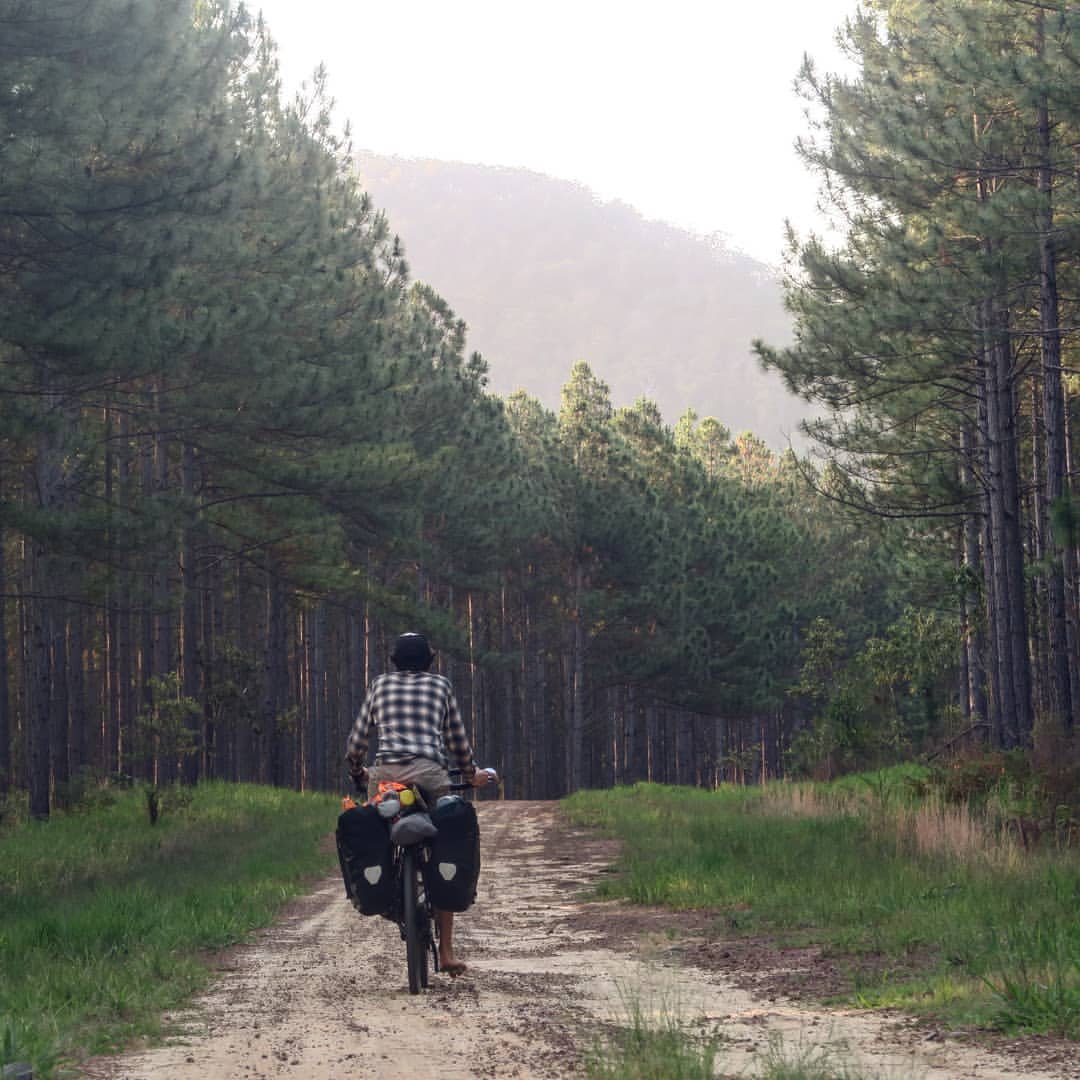
Much like the diverse range of touring bikes available, the market is also rich with various styles of panniers to suit different touring needs. Whether you’re setting off on an extensive cross-country adventure or planning a brief weekend escape, selecting the appropriate panniers can greatly elevate your experience. In this article, we delve into the world of panniers, offering insights into robust touring options, streamlined micro bikepacking choices, and minimalist solutions for those who favor a lighter setup.
What About Specific Touring Bike Handlebars and Saddles?
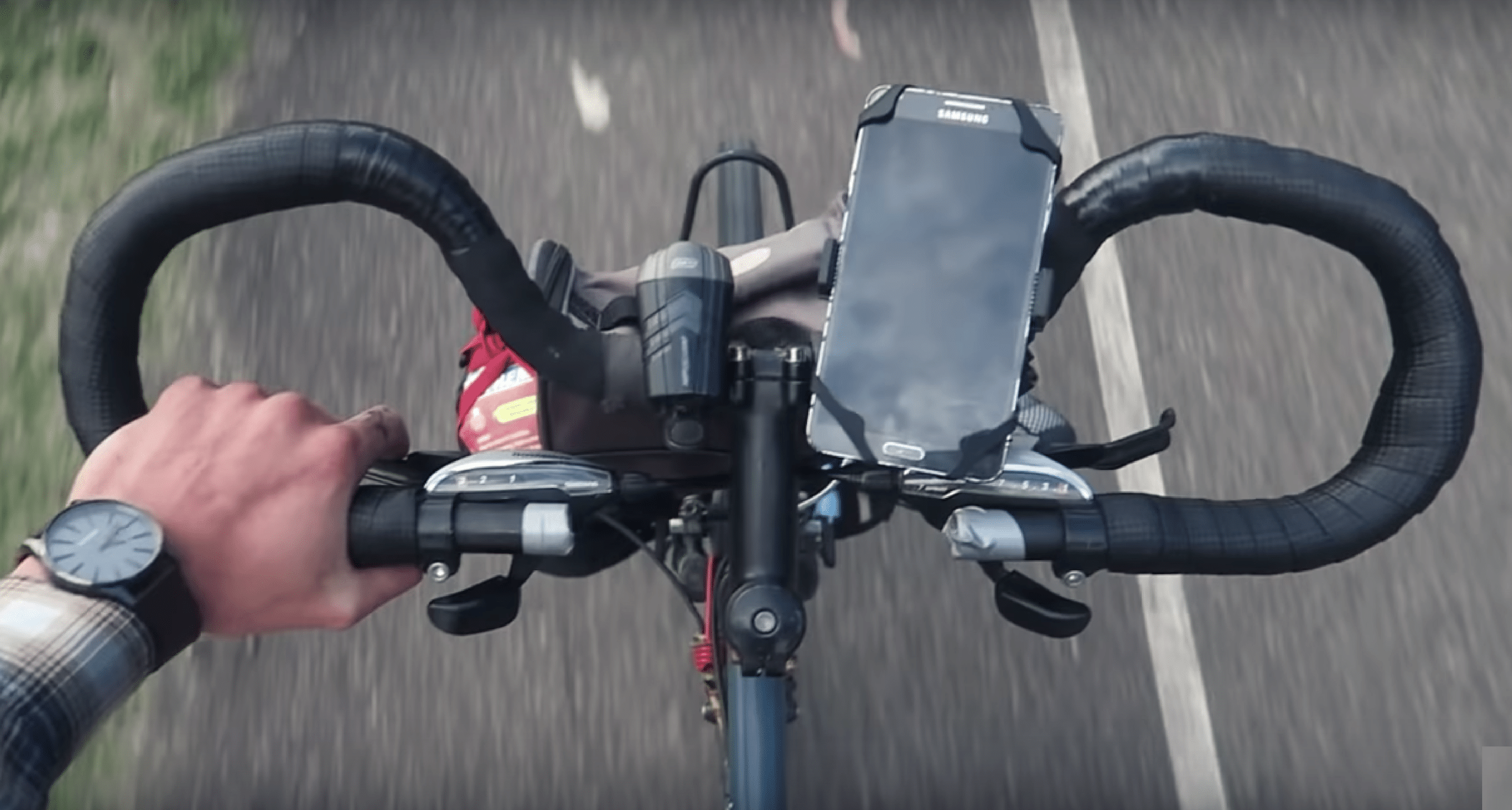
When embarking on bike touring or bikepacking, comfort is paramount, especially considering the main body contact points with your bike. A crucial aspect of this comfort is finding the right handlebars, which can greatly impact your experience over the many miles ahead. This article focuses on what to look for in touring handlebars and presents some of the best options available.
Choosing the right saddle for your bike touring or bikepacking adventure is a decision that can significantly affect your comfort on long rides. In our latest article, we address the essentials of bike saddle comfort and how to select a saddle that reduces discomfort for extended periods in the saddle.
A comfortable bike saddle is crucial, especially when you’re planning to spend days, or even months, pedaling across diverse landscapes. It’s not just about picking any saddle; it’s about finding the one that fits your unique body shape and riding style. We explore the factors that contribute to saddle comfort, from shape and size to materials and design.
Are Touring Bikes Good For Commuting?
Touring bikes are a great option for commuting due to their unique combination of durability, comfort, and carrying capacity.
Designed for long distances and varied terrains, these bikes are robust enough to withstand the daily wear and tear of urban travel, ensuring longevity.
he upright and relaxed geometry of touring bikes offers significant comfort, which is crucial for daily commutes, especially over longer distances.
This design effectively reduces strain on the back, neck, and shoulders. One of the key advantages of touring bikes for commuters is their ability to carry loads. Equipped with racks and multiple mounting points, they are ideal for transporting work essentials, groceries, or other personal items. Want to use a touring bike for commuting?
While touring bikes are versatile and perform well on different surfaces, making them suitable for various commuting routes, they are generally heavier than road bikes.
This might not be ideal for those who need to frequently carry their bike.
Additionally, they might not be as fast as road bikes, which could be a consideration for those with longer commutes seeking speed.
Moreover, the focus on durability and functionality often makes touring bikes more expensive than some basic commuter bikes.
Despite these considerations, touring bikes offer a reliable, comfortable, and practical solution for daily commuting, balancing efficiency and stability, especially when carrying loads.
Other Touring Bike Reads
- The Tips, 67 bike travellers wish they knew earlier – Beginner Bike Touring Advice
- Best Bike Touring and Bikepacking Handlebars – Everything You Need to Know
- Gravel Bike For Touring – 6 Best Gravel Bikes For Touring!
- 12 Best Front Bike Racks For Touring & Bikepacking
- Best Off-Road Adventure Touring Bikes 2024
- Best Flat Bar Touring Bikes & Expedition Bikes
- Best Touring Bike Kickstands & Everything You Need To Know
